#in the media showcase the sequence of movements at the end is:
Text
fun thing about same scent's choreography is how the beginning mirrors the end. hwanwoong acts like the snake trapping seoho while the rest of oneus forms a tree. seoho covers his eyes then leans on hwanwoong. towards the end, they go back to formation and seoho "picks the fruit" from hwanwoong (in the mv, there is a close up of seoho bringing his hand to his mouth first after he touches hwanwoong) then everyone lets their hands fall as if the tree "withers"
in the media showcase, we pause in this formation to see the white snake in the background rising up, because "temptation" won. man I love the little details in the choreo for this
edit: well I can't really edit this now since the original has been reblogged but if you're reading this version please check the tags on this one for added details!!
#mine musings#oneus#i cannot gif so i can't point out the scenes but your get what i mean#anyway we need a fullcam version of the choreo because ahhh the small details like them praying and stuff....... really neat.....#edit: i can't edit this now because it's been reblogged but omg i noticed another thing#in the media showcase the sequence of movements at the end is:#woong sings the last line about scent > they form the tree > woong brings his hand out in the direction of seoho and opens his hand#> AND THEN seoho takes the invisible fruit > eats it (very quickly) > all the hands fall / the tree withers#therefore woong actually offers the fruit...?#the offering also happens very quickly in the beginning after seoho leans on woong but instead of eating it he actually throws the fruit#which makes sense bc he's still resisting but ofc as the song progresses the nostalgia deepens and so he would give in at the end#idol musings
48 notes
·
View notes
Text
Okay so because I’m gay and mentally ill I have decided to take it upon myself to go through Kafka’s demo frame by frame and overanalyze the shit out of anything I find interesting
It’s insanely packed with blink or you’ll miss it details so buckle up folks- this is gonna be a ride
Right off the bat she starts off with the same coin she also ends the demo with. This isn’t something that’s been part of her character so far nor do I think it has any real significance, so she just brought it to be extra and torment the poor souls she’s planning to slaughter anyway. Annoying dramatic bitch

Also just to get this out of the way now, this is indeed the Belobog museum, or at least its assets. The floor of some of the inner rooms, the staircases, the chandelier and the big golden clock thingy are the same, and in one of the shots you can clearly see the portraits of the former supreme guardians which is. Makes you wonder if they just picked the museum for grand dramatic interior or if she actually had reasons to have business there.

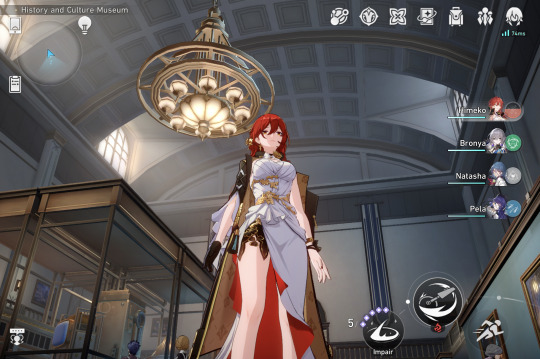
This. This fucking part is probably no longer than 5 seconds and yet, even with the video on 0.25 speed I had to constantly rewind and pause to catch everything and it still probably isn’t 100% accurate. Also I had to cut out a lot things because Tumblr only allows 30 images per post but like, you get the picture




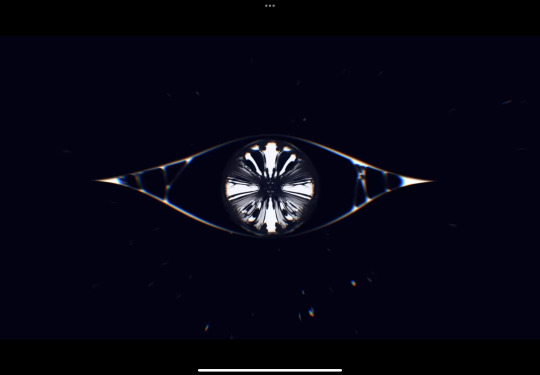
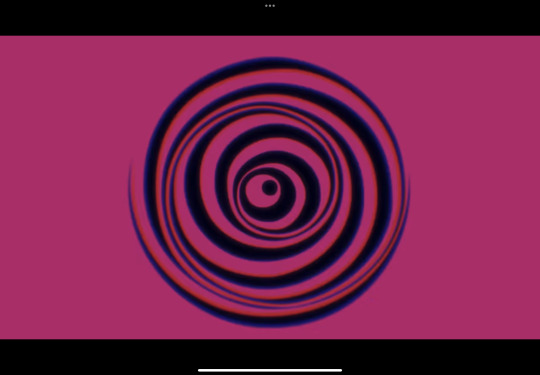

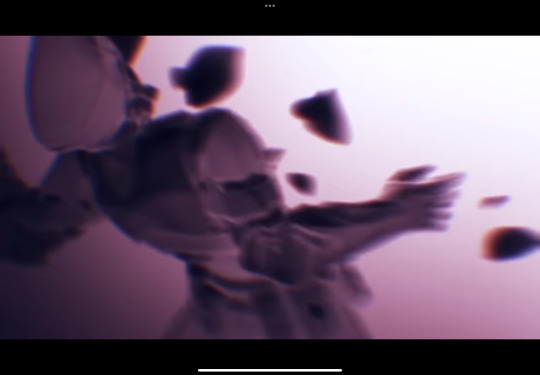


“What do you see” over and over again as images of Rorschach tests flash across the screen so fast you barely have a chance *to* see. Personally I mainly see spider like things and butterflies. Among them are images are some flashes of the robo guards, which to me give the feeling of them getting caught in her web, losing themselves and their control to her mind games and technique.
Something else worth nothing is that this sequence is kickstarted by her throwing the coin and ends with it still in her hand, just thought that was an interesting choice


Before moving on to the next point, however, I want to point out the obvious irony of her telling the guards “don’t be afraid”. Truly words to hear from the woman who is incapable of feeling fear. And what is the name of the demo? Dramatic irony. We’ll get back to that.
Anyway, after that we see the camera pan away from her and over the guards as she uses spirit whisper. The camera movement is accompanied by a single rose petal that starts from Kafka and flies over the guards, which kinda feels like the visual representation of spirit whisper, a gentle rose petal innocently brushing across them as if carried by an invisible breeze
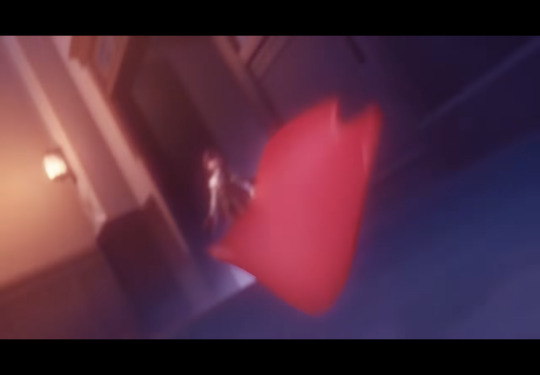


I wanted to make a joke about how her bounty is as large as her strap but seeing as I’m restricted in the number of images I can put I’ll just state the obvious and say she has the largest known bounty of the Stellaron hunters. I’m going to guess the only one higher than hers is Elio’s.
can’t be 100% sure this is what’s going on here, but the imagery makes it look like she’s taking a nice calming stroll and playing Vivaldi in her head while letting the guards slaughter each other, either by controlling them with her strings or with spirit whisper

Dozens of hands reaching out for her, trying to grab her as she’s cocooned in a vulnerable state, pupils visible. I’m sure we’ll eventually get an ingame explanation as to what’s actually going on with her eyes, but for now I do think this is a VERY interesting time to show them. She’s in a compromising position, she’s cornered and vulnerable, but she’s confident and cocky and always, always in control. To anyone else this would be horrifying, but she can’t feel fear, why should she care. Like genuinely this is terrifying imagery that in media is more often than not used to showcase or symbolize sexual violence of sorts and personally makes my skin crawl. I don’t want to get too much into it here I think it needs its own separate post, so for now I’ll keep it short and say that up until now, her pupils have only been shown in situations where she’s at a physical disadvantage (held prisoner at the divination commission, whatever this is etc)


Something a bit lighter to focus on is what she’s saying; “the silk is too fragile to be a treat… unless you’re more fragile than the silk.” Symbolism aside she always seems to refer to silk when talking about fragile things, which we know are, in her opinion, the most beautiful. I really don’t think she’s referring to herself here seeing as the next scene demonstrates she’s far from fragile, so I think she does mean it in a much more literal way and is talking about a spider web; too fragile to capture humans, strong enough to capture its intended prey, this being weaker bugs. All in all she’s probably insulting them by comparing them to bugs weaker than a fragile silk web.
Nothing much to say about the fight scene other than that it’s incredibly choreographed and confirms that Kafka is strong enough to roundhouse kick a guy in the head (god I wish that were me) and do backflips in midair while firing her guns. Also the elevator counting down the survivors as their forces dwindle is fucking rad.
“Destiny has thousands of faces, why does it choose to wear this one?” In the context of the scene this reads to me as her mockingly lamenting the guards’ fate as she beautifully takes them down one by one, but it’s also one hell of a peculiar sentence from someone working for a guy who supposedly sees destiny and directs his followers according to that. She’s a nihilist, everything is predetermined in her eyes, she’s one of destiny’s slaves, but destiny also has thousands of faces? Is she really so nihilistic that even her own worldviews are contrasting in her eyes? As I’m writing this it makes me think of dadaism more than anything else. To quote from wikipedia: “an early 20th-century international movement in art, literature, music, and film, repudiating and mocking artistic and social conventions and emphasizing the illogical and absurd.” Kafka herself in an artist in many ways; she’s an actress first and foremost, always dramatic and theatrical, following a script to a T. But she’s also a musician, everything about her steeped in classical music and references. Anyway, dada is an absurdist nihilistic movement, and you know which real life author known for his absurdism lived and wrote parallel to the Dada? Franz Kafka.
Genuinely Idk where I was going with this I just thought it was worth sharing, MOVING ON-
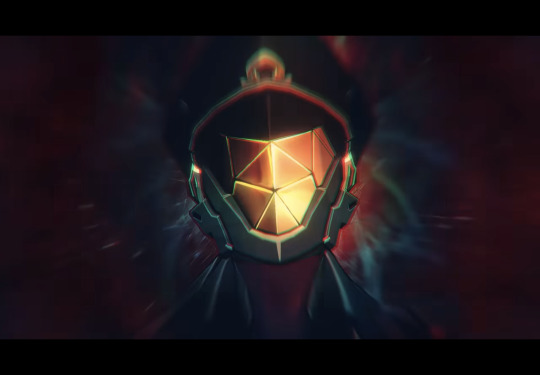

Neat way of visualizing what I’m assuming is supposed to be her spirit whisper. Also I’m extremely stingy with images (thanks Tumblr), but if you slow down the video around 1:17 you could see that the shot of her katana very quickly flashes into another spider, just wanted to mention that.

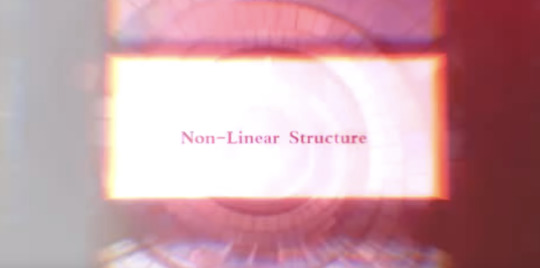
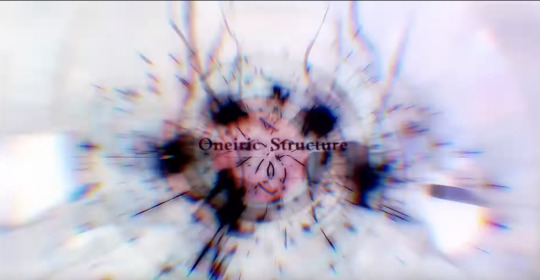
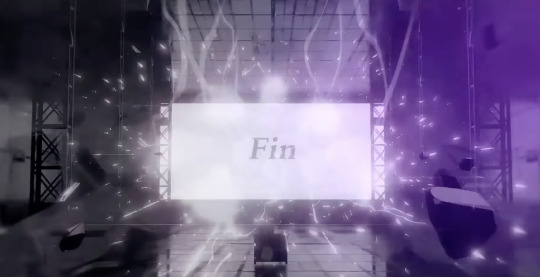
These are all narrative screenplay terms that flash by in like a millisecond each after the big ult (that, btw, has a similar shot saying ‘intermission’ right before she casts it but it flashes by so fast and with such bright colors that I couldn’t take a proper screenshot of it) and shown on the Belobog Museum’s projector. The most interesting one here imo is Oneiric Structure; “a cinematic story using dream like visuals, exploring the structure of dreams, memories, and human consciousness”, very fitting considering how much of her abilitieseing how dramatic irony is yet another narrative device.
All these movie terms and framings, however, feel to me more like a wink to Kafka’s roots than anything else. This is the third time she’s been tied to movies somehow (the web event, one of her leaked messages that actually mentions how she’d hate for her life to be turned into a movie), and this is one time too many for me to stop denying that the inspiration for her character was at least in part Makima from Chainsaw Man. I won’t elaborate too much not to spoil the 3 people unfamiliar with csm, but this whole thing feels like a homage, a love letter to Fujimoto’s own love letter for cinema.
Also she *is* an actress following a script, so there’s that as well.

The demo ends with her taunting the one remaining guard with the very same coin from the beginning, flipping it in her palm and asking the guard to guess the ending with heads or tails, prefacing it by saying “sooner or later, the curtain has to fall”. To me this indicates that she sees life as kind of a one gigantic play, with no fear and no value for human life everything is a performance to her, it doesn’t matter beyond what’s happening on the stage in the presence. But also the way this is all framed makes it very easy to assume she’s actually talking about the end of the guard’s life, and asking him how he thinks this encounter between them will end, lol.
Another thing about the coin that Meadows mentioned “her flipping the coin over and over is both like, play with fate, a distraction (like, think in movies, you see someone flipping a coin your eyes are drawn to it and not the sleight of hand happening elsewhere), and ofc her clear obsession with vintage shit”
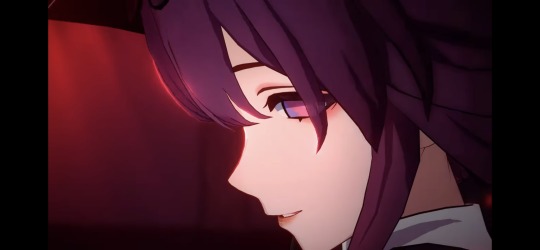
This has been it from me for now, too dead to properly edit through this rn so I’ll probably go back and add some details once I’m feeling better. Would also love for anyone to chime in with their own conclusions since this is just one person’s interpretation. Especially if you have more knowledge than me about classical music and have ideas regarding the use of Vivaldi’s winter

#honkai star rail#kafka#character analysis#More like demo analysis but whatever#And good luck to everyone pulling tomorrow!!!
46 notes
·
View notes
Text
January 10th, 2021
Action Button Review
Review
Tim Rogers reminds me of Hank Green. They are about the same age, they look about the same age which is a combination of young and old that feel eternal. They also have the same length of experience in writing in online spaces, interest in Japanese media, and apparently have Crohn’s disease? In summary, he might be the closest equivalent to Dave Green that exists in the real world. Well, I guess Dave Green is not apt, as Dave Green is not special in a way, while Tim Rogers is special, but his speciality comes from his failures rather than his counterparts' success.
Tim Rogers is a hypothetical Green brother who did not decide to publish that book. He’s a hypothetical Green brother who went to Japan instead of Alabama or Florida. Whose project crashed and burned rather than a surprise success. He’s forged in fire while the Green brothers are eroded by water. Both are wonderful people, but with a different ground of intensity and differing wealth of wisdom.
I encountered this series because I found a twitter post about a six hour review of Tokimeki Memorial, and a white middle-aged man talking about a dating sim for six hours with laudatory blurbs would always pique my interest, but since I didn’t know the guy, I went ahead and looked if he made other videos, and found he has four other review that were all about three hours or more. Now I knew that I had to watch all the reviews to prepare myself for this six hour review of Tokimeki Memorial.
Now, I wasn’t a stranger to three hour reviews of video games. I watched Joseph Anderson, Raycevick, Whitelight, matthewmatosis, and Noah Gervais-Caldwell. In fact, in the comments below Action Button Reviews, many people talked about a comparison to Noah Gervais-Caldwell (and Brian David Gilbert) and that was quite funny since I actually watched a recent Noah Gervais-Caldwell video.
His first two reviews were perfunctory, him opening himself up and trying out new things and polishing his review style, as he went through the Final Fantasy VII remake and The Last of Us. While I watched The Last of Us, I distinctly remembered and contrasted Noah’s The Last of Us Part 2 review with Tim Roger’s The Last of Us review. I liked Tim Roger’s defense of interactive movies (although he denies it!) contrasted with more cynical but ultimately positive connotation in Noah’s review. And Noah’s thesis pairs nicely with Tim’s observation that Ellie was the main protagonist all along. That fact makes Part 2 much more understandable, even the bad parts.
When I finished watch his first two reviews, I went ahead and also watched several of Tim’s videos on Kotaku, which were slightly shorter, the longest being just over an hour, which is a review of the best games in 1994, and does contain a short segment about Tokimeki Memorial, which his six hour review was my destination. To put in context, Tokimeki Memorial was #3. #1 was Earthbound, #2 was Final Fantasy VI, and #4 was Super Metroid. And I just watched a playthrough of Super Metroid basically on a whim, because it’s a monumental and a great game to play and watch.
And while the segment of the games that I knew to be great and monumental in my absorption of knowing video games was deeply personal and rightly claimed its stake that it deserved its spot, his segment of Tokimeki Memorial never got there. It was almost as if he was deliberately hiding behind something. In the end of 1994 review, Tim pitched an idea about a three hour Earthbound review, which probably was Tim’s idea of floating a departure from Kotaku, which would happen two months later, and I wonder if he was trying to deliberately throw a curveball by making a video of Tokimeki Memorial instead of the promised Earthbound review. This may be a far leap, I admit.
I went back and watched the video about Doom. It was much better in quality and in darkness. I was reminded of Film Crit Hulk’s writing of The World’s End and James Bond, another very long essay that was deeply personal and chapter for easier consumption. Few commenters noticed that Tim Rogers was just doing a dramatic reading of his written reviews on Kotaku and Action Button dot net, and how they liked that approach, and I found myself liking that approach as well. You might believe a video review needs more than just reading an essay out loud, but just the act of reading an essay out loud in the correct intonation and inflection adds ton to experience. And Tim Rogers sounds like he has decades worth of experience to present a dramatic reading of his essay very effectively, much like Hank Green.
I continued scaling the mountain to my goal. I went through his review of Pac-Man and was delighted by his reading of Namco games, and was impressed by the opening sequence, and just generally enjoyed it. I was getting excited to set a day aside and let the six hour review of Tokimeki Memorial watch over me and reduce me to dust.
And it sure did. That six hours was a harrowing experience. What Tim Rogers is best at is telling a story, and so to go through a let’s play was a wish I never made, fulfilled. In the end, I was left with nothing and everything. It was like finishing a really good book.
I wanted to watch it again, then again I never wanted to watch it again. It was almost a traumatic experience. Tim talked about there being endless variation of love, and the love Tim Rogers went through was not the fluffy yet melancholic one that I craved, but one akin to a devotion of an eldritch god. Love made in justification for one’s efforts in attending and maintaining a relationship. A love stronger than most kinds of love, but most draining and taxing as well. Tim Roger’s synopsis of Tennis Monster reminded me of Asking for It by Louise O’Neill, which is also about empathizing a quite hateable character because we kind of have to. Apparently one person knows the full plot because Tim Rogers rambled on about it as he was couch surfing in his house, and unbelieve as it usually is, I fully trust that the commenter is telling the truth.
I was like a heroin addict, who really wanted a different hit, like talking to friends or hiking, my mother wanted me to go hiking with her, and I didn’t because, after the pandemic started, all I wanted to be was inside. Outside felt diseased. The air outside felt contaminated to me, hard to breathe. I was stuck in this place.
Tim Rogers is an exceptional figure. He seems to be a movie protagonist, he reminds me of The Librarian, played by Noah Wyle. Tim has eidetic memory, as he has access every single autobiographical memory formed, but not other types of memory. We know that those types of memory are different because of people like Tim and people who are opposite of Tim, someone who has no memories of autobiographical memory but otherwise fine. These people tend to have very few emotions and have a hard time deciding things. Lack of emotions is correlated with difficulty in decision making.
So Tim is the opposite of that, Tim is full of emotions, complex emotions and he can make decisions and carry it out in a snap. He would be good at school, and he was, but he would be too focused on his grandeur to be under some authority, which is how he became who he was. His anti-authoritarian nature rings throughout his reviews, highlight the general Generation X vibe that Tim exudes but also the modern socialistic movement of Generation Z, which adds to this odd mix of old and new.
Not only does Tim have eidetic memory and intense work ethic that he never seems to move away from, therefore making a three hour video masterpiece at a clip that seems unbelievable for a seasoned viewer, he also has exceptional skills in fast math and language, he seems to be at least familiar with dozens of languages, and of course Tim’s experience is bounded by his decade of living in Japan.
I think this is why Tim naturally gravitates towards video games. When Tim says ‘welcome to video games’ there’s a natural supposition that Tim Rogers is the protagonist of video games, and I think he is. Tim wants to be in video games, because he needs to be in video games, instead of some almighty god cruelly deciding to plop him into a real life. He should be an video game adaptation of The Librarian and go on world-spanning adventure and romance impossibly beautiful girls instead of toiling the grime of what real life portends to. His life is dramatic, but impossibly mundane as well. It’s a simulacrum of a movie or a video game, which is pretty cool on its own.
But of course Tim Rogers isn’t the only part of Action Button Reviews. In the ensuing five videos, Tim Rogers tries to do something. Video games are a wide net. There is so much to video games, something like Gone Home and Geometry Dash are included alongside Wolfenstein The New Colossus and Farmville. What makes a video game? Actually, the more interesting question is, why do we have the term ‘video games’? Why do we put all of this mess into a single category, as if there is some throughline.
Tim Rogers starts to do that. Tim Rogers boldly states that things like Doom and Tokimeki Memorial are intimately connected to each other. And that all video games are in conversation with each other, through deep and complex meta-narratives. Tim Rogers is a cartographer, trying to map out how video games are made whole.
I’ve always strived to be that kind of a cartographer, to showcase the weave of reality, of connecting two seemingly unconnected parts, and showing to a profound implication both existing, instead of one or the other. If you don’t know, I have been trying to write something out of my current obsession with Virtual YouTubers, and mostly Hololive, and while I think I stumbled upon the six hour video review of Tokimeki Memorial outside of my interest in virtual YouTubers, this video, as I expected in the back of my head, gave me plenty of thoughts about Hololive. Its rumination of cyberpunk and idol culture is so directly connected with the peculiarities of Hololive that I was quite astounded.
From the very beginning, I wonder how Tim Rogers thinks about Hololive, especially after he has done that six hour review. I’m sure he will have a lot of interesting thoughts about the prospect. I want to get in contact with him, maybe work under him. But then I don’t want to hang out with him. I want to be near him as he talks to a crowd at a party, but I don’t feel safe to be near him when there’s less than ten people nearby. I think below ten, I would be swept in some danger that I won’t be prepared for.
Tim Rogers and Action Button Review is a fascinating review series and if you have the time, I suggest you should take the journey. It’s well worth it, just to get a different perspective on video games and the world around it.
22 notes
·
View notes
Text
Making Performance 2: Research and Process Blog
Introduction:
My name is Charlotte Baldry and I am a second year BA(Hons) Drama student at Bath Spa University. I have begun this blog in order to have a platform to display my research journey and creative process for a module called 'Making Performance 2'. This production based module builds on our pre-existing performance making skills, centred around the theme of 'Delight'. At the end of the semester, we will have a digital showcase via Zoom. The criterion for our pieces is that they have to be centred around the genre of documentary, auto-ethnography and verbatim performance. We were given the choice to either stage a play, performing an adaptation of a documentary podcast or devising our own play. Our group chose the option to devise our own piece, the following blog is about the creative process and external influences that we have taken inspiration from to form our piece. I hope you enjoy it! -Charlotte Baldry
Performance Overview:
I've always wanted to delve into the archives of sex trafficking as since there isn't heavy media coverage on the issue and it is often pushed under the rug, so when the option arose to discuss ideas for a devised piece, I suggested the idea to the group, and soon the ideas started flowing rapidly. Our main themes to cover in the performance consist of: Delight, Loss Of Identity, Corrupt Society, Rape, and Escapism. We had to hone in specifically on what themes we wanted to portray in the piece, otherwise it would've got very crowded and unclear for an audience member, so we decided to focus on loss of identity and the front people put on for people to see versus what is lying beneath the surface, and also explore how after years of experiencing the sheer trauma of being trafficked, you are only seen as a 'number' in a long list of statistics.

Summary of our group’s creative vision for the performance:
Naturally, our initial instinct was to shock the audience, due to the fact we were dealing with such visceral subject matter. After many rehearsal calls and experimenting we decided that was going down the obvious route, so we chose to delve deeper, and realised it would dramaturgically benefit us to entice the audience into the plot of the story and then shock them through the technique of strategically juxtaposing movement sequences with the emotional tone of the dialogue. For example, in the first section when Lea plays ‘Sophie’ she sounds cheery when talking about her going to Italy with Caz, and then him enticing her into ‘work on the streets’ (meaning prostitution). To show the front that the character of Sophie put on as her identity was lost.
Research Process
The style of our piece is verbatim theatre, so we started off the research process by sourcing multiple victims stories and filtering through their interviews to see what would fit dramaturgically in an attempt to raise awareness about sex trafficking. A lot of us also weren’t too clued up on the nature of sex trafficking, so we watched a few documentaries to become familiar with the topic and ensure that our piece was not offensive and had one hundred percent accuracy.
Description of and justification for key dramaturgical decisions in relation to the performance:
After having watched Sherlock in Homes, I thought that using the breakout rooms would be really effective since in live theatre you cannot do this, so we thought we would use the fact our performance was online to our advantage. We were going to have a live interactive sex trafficking scene with the audience where they were unaware that’s what they were actually participating, reflecting how the victims felt when they realised what they had been forced into, however, after discussing the logistics of doing this, we realised it wouldn’t be guaranteed to run smoothly, so we then chose to use pre-recorded clips of a catwalk, which later is revealed to be ‘adverts’ for the victims being trafficked, so the audience are enticed by the fun and sassy nature of it, to then suddenly being shocked as to what it actually was for.
Another key dramaturgical choice we made, was performing with sacks on our heads. We chose to do this because it represents our main theme of loss of identity since you cannot see our faces and there is a case number written at the top of the sack, this also gave clarity to our multi-role since we changed our names on zoom, to the case number that we were representing. The sacks also helped us portray the stimulus of delight, since at the end Nike and I take the sack off off Iona’s head, and I ask “What’s your name?” and she turns around as if she needs to put the sack back on, but instead in that moment, regains her identity and delight.
We chose to multi-role since when we each had our own characters, overlapping the stories became complicated, and we realised it wouldn’t be as meaningful to the audience, if they were overloaded with information, and by focussing on three, they could gain a connection to the characters.

Company and Artist influence:
The two main companies that influenced our performance style were Complicite and Frantic Assembly, since we decided we wanted to incorporate physical theatre in our piece.
After researching Complicite, it became apparent that they didn’t have a particular performance ‘style’ or ‘method’ and that ‘each piece is made according to the subject matter’ (Complicite – Essential Drama, 2021). As for Frantic Assembly, Scott Graham, the Cofounder and Artistic Director said “Performers are encouraged to take a moment back to its simplest truth and build from there.” I began pondering how to choreograph the chair duet by stripping the subject matter back to basics, the ‘simplest truth’, which was: violating, raping bidding, and dehumanisation. Narrowing it down to five words made it a clear decision, the chair duet would be showing the process of a victim being trafficked. We met up in ANG15 soon after and I started to get Iona, Tasha and Lea to experiment with different moves and once the ideas got flowing they contributed some too, based on what ‘felt right/fitting’ in the choreography, which is the basis of Complicite and Frantic Assembly’s method. This resulted in a video just over a minute long, of them telling the stories with their bodies, as opposed to voicing it, forcing a visceral reaction from the audience because subject matter like this, hits harder once there is an uncomfortable visual representation of it.
Online Performance Evaluation:
Tom Marshman’s Shakesqueer (27 Feb 2021)
Tom Marshman's Shakesqueer began with the computer screen on a trolley with wheels which meant he was able to 'drag' the audience into his closet (his personal space) which was symbolic to the idea of the LGBTQ+ community having to 'hide in the closest' from society, this functions as an example of digital performance because in live theatre one can attempt to 'create a personal space' but it isn't authentic, as opposed to being let into someone's home. He also used various media effects in the piece, pre recorded video clips with a mirroring effect on, and was able to split is screen in which we had a birds eye view of a drawing of Henry VIII, which would have been more difficult to achieve in theatre. Since our piece also has to be on Zoom, inspired by this piece, we will also use pre recorded media, and then do split screen physical movement while the monologues are read, so we have a good balance of dramaturgical techniques.
Sharp Teeth’s Sherlock in Homes (4 Mar 2021)
Sherlock in Homes was an incredibly eye-opening piece into what a digital performance can achieve in terms of audience interaction with one another. They gave us a summary of the case and then split us into breakout rooms, which would have been logistically more difficult if we were in a theatre space, we were given the task to collectively solve a murder and given the option to vote on polls. This gave a community feel to the audience and we wanted to do this in our piece, break the fourth wall and immerse them into the narrative, so we experimented with the idea of including a poll at the start of the play and then separate them into breakout rooms and take advantage of the digital platform, however practicalities meant this was not achievable.
Tobi Poster’s Chang Eng and Me (2021)
Tobi’s piece, Chang Eng and Me is about the first pair of conjoined twins and follows their journey though life and death. Tobi didn’t ever include a frame of a full face, which made the voiceovers even more captivating since when there wasn’t much visual stimulus at points, you really heard the words and they resonated with me a lot. Therefore in our piece, when reading our monologues we are reading our monologues with sacks on our heads, since it links with the themes of loss of identity and aids with multi-role, but also will make the text stick with the audience.
Evaluation
In our group I took on the role of the lead creative designer, so I decided to incorporate the shadow sequences, chair duet, and other physical movement scenes. I choreographed the shadow sequences collaboratively with ideas from the whole group, and had help from Lea in making the chair duet. I am really happy that I took on this role, because my learning style is very visual, so being able to bring the harrowing text to life via movement, really sparked up my ideas and made me feel very passionate about the piece.
As a group, I felt that we had a very good dynamic, we all became friends and therefore respected each other and created a comfortable work environment which made the process really enjoyable! We were very good at testing out ideas each member thought of and giving constructive feedback on whether or not it worked for our piece, however sometimes on the group calls we would go off on mild tangents on things that didn’t end up being used in the final production, so perhaps we could’ve had more time refining our performance if we hadn’t have spent so much time dwelling over ideas we had a feeling weren’t practically going to work, like the breakout rooms. One error I personally had was turning my camera and mic off with the sack on my head, they weren’t very transparent so after my monologue my hands fumbled in trying to find the buttons to stop my video and audio, so the end was not as slick and professional looking as I would’ve liked.
I am really happy we were able to perform together on campus through the computer screens, because the shadow work was really effective in activating the audiences emotions, a few of my peers informed me, and also we had the pre-show atmosphere as a group which enabled us to bounce off of one another's energy, creating a greater sense of achievement when the show had ended.
If I was to make this piece again, I would like to experiment with the advantages to it being performed online a little more, because we did play with camera angles, breath, proximity and breaking the fourth wall through passing objects through the screen, however I feel one thing we missed out was audience interaction, even through a poll to create more of a community feel to the piece.
One of the things that stands out to me that I will take away from our performance, is the power of juxtaposing scenes and emotions and how that will speak to an audience so much more than a piece that just shows the bad side of emotions, it takes them on a journey and has an element of surprise, meaning hopefully the message sticks with them after they have left the call, since it is so easy to watch a show, then as soon as you leave the theatre/call, leave the message behind.
In the future I will always weigh up the practicalities of my creative decisions straight away in order to save time and ensure the performance runs smoothly with no risk whatsoever. I will also carry the energy we created in the group of a friendly safe community space because it made the process easier and I will always remember how happy and secure I felt with them.
FlipGrid video material:
https://flipgrid.com/+2021mp2b4
https://flipgrid.com/+2021mp2b6/573404f4
https://flipgrid.com/+2021mp2b8
(Video explaining will be shared with Laura on google drive).
Bibliography
http://www.endslaverynow.org/blog/articles/shamere-mckenzie - Shamere McKenzie’s story.
https://blog.theexodusroad.com/human-trafficking-stats-stories-boys-are-sold-too - Ram’s story.
http://antislavery.ac.uk/items/show/2706 - Sophie’s story.
https://www.franticassembly.co.uk/the-frantic-method
http://essentialdrama.com/practitioners/complicite/
https://www.youtube.com/watch?v=ieWs3hl3O4w Frantic Assembly show reel.
https://www.youtube.com/watch?v=6mqTCoM3zd0 Complicite show reel.
Tom Marshman’s Shakesqueer
Sharp teeth’s Sherlock in Homes
Tobi Poster’s Chang Eng and Me
1 note
·
View note
Text
August : 1st Week
Heyyyyaaa!!
AS Level media studies is becoming more and more interesting day by day. The brainstorming for AS Foundation portfolio has started on a personal level. And the theory part is also going parallel.
Migraine
There is an acronym developed for the key media concepts. It is called MIGRAINE.
M- media
I- institution
G- genre
R- representation
A- audience
I- ideology
N- narrative
E- environment
Denotation
This is what an image actually shows and is therefore immediately apparent to the audience. Literal definition of a word in a dictionary.

Connotation
This is the meaning that the sign has and is arrived through the audience’s cultural experiences. For example the color red has a lot of meanings,

Anchorage
It is a way that various elements of media language, when combine, help to fix or limit the meaning to the audience.
For example, the caption that accompanies a photo in a magazine may drastically alter the reader’s interpretation of the photo, and so captions are utilized by the creators in order to ensure that the correct meaning is being decoded by the audience.
Clip Analysis
Bypass - 2003

This week we analyzed many sequences from several different films under the categories representation, camera, editing, mise en scene and sound.
The first film which we analyzed was a 15 min Hindi (Indian) short film, titled Bypass. Directed by and written by Amit Kumar.
The film is about two friends who stay by the stranded road “Bypass” and a corrupt police officer. The two friends frequently rob off and ultimately kill the people who travel by the road. Amit Kumar starts the film by showing a newlywed couple travelling by the road, and Nawazuddin Siddiqui stops the car by throwing a rock. The two friends then steal money and kill the pair. Irrfan Khan’s role as a corrupt police officer is established when he takes a watch by cutting the wrist of a dead man, then rapes a lady and tries to kill the two muggers for the money they had. The director represents the thrill of “Bypass” through violence and aggression.
Meghe Dhaka Tara - 1960

This is a Bengali B&W feature film. We analyzed the opening 4 minutes of this film. I observed a few things which I would like to state here, for instance, the camera movement was very limited an there was rarely any use of moving shots.

As this film was in Black and White, it made me ponder a bit over it. Just after a while I watched another black and white (but contemporary) YouTube series titled, ‘Kota Factory’. Again this is a very recent Indian production. The overarching intent of this series is about students studying in coaching centers and taking aid from dummy schools to get into IIT (Indian Institute of Technology). And how the education system students follow in Kota (education hub in India) grills them completely and the enormous amount of pressure felt by them.
The creators of this series, use black and white as medium to showcase their product, so that they can show the gloominess, unpleasant, dull and not so lively environment. Ps:- Lack of color in the lives of the characters. But at the end when the lead character’s life changes, then in the last shot red color slowly creeps in the frame. This is a very beautiful representation and it signifies entering of happiness. In India red color has a connotation of auspiciousness.
Fight Club - 1999

This film is one of my personal favorites. Actually, who’s favorite isn’t this film? I like films which deal with ‘psychos’. I am an avid reader, so when I watched this movie I could relate it with Sydney Sheldon’s novel ‘Tell Me Your Dreams’.
We only analyzed the airplane sequence. Though foreshadowing could be seen but I don’t know if we were allowed to take references from the complete scene. I mean foreshadowing could have only been established if the complete movie has been been watched.
That’s all for this week!!!
1 note
·
View note
Photo

youtube
Everyone needs to have Maja Kristina on their radar immediately. She is an incredible artist that is straight out of our pop dreams. Her whole self-titled EP is absolute perfection. Maja has released the song ‘Jessica’ off her EP as a single, and she couldn’t have made a better pick. ‘Jessica’ is a new take on a breakup song that we hope to see much more of. It’s written with the mindset that the person that cheated is at fault, not the person they cheated with. That is the mindset everyone needs to have! Maja sings, “Cause she seems really nice, and I think in the end, Me and Jessica could be friends.” We love to see women lifting up other women, instead of adding to the teardown. It’s a breath of fresh air. Normalize shaming cheaters, but not other manipulated women. [via The Honey Pop]
youtube
Lucia & The Best Boys have shared a new video for ‘Forever Forget’. It’s a cut from the band’s recent EP The State Of Things, it arrives alongside the news that their upcoming support tour with Dream Wife has moved back to 2022. Speaking about the video, director Rianne White says: “'Forever Forget' is a landscape of a feeling. Lucia and I wanted to create a piece of choreography that exists in a solo otherworldly space shaken up by an unsettling sensation of feeling trapped. Guarded by multiple camera perspectives, this movement sequence is shattered like a mirror into pieces and dominated by a blinding sensation of overwhelm, refracting the internal electricity of the brain into view. This video is a portrait of inner turbulence, liberated by Lucia’s untamed and magnetic expression of self. Frontwoman Lucia Fairfull adds: “The 'Forever Forget' video concept has kept completely true to the meaning of the song, 'Baby you've taken me to higher places. It hurts if it's just in my head', is the first lyrics of the chorus. The video portrays this with an other-worldly head trapped space, along with the choreography expressing a state of wanting to escape your own mind and thoughts. The lyrics throughout speak directly about wishing you still had what you once did, but having to face the reality that it is no more, and then trying to erase the memories from your head and move on. Making videos has always been one of my favourite parts about being an artist and over the last year I’ve really detached myself from the idea that I need to be perceived in a certain way and have enjoyed being more adventurous with Visuals. I have imagery almost as soon as Ive written a song so bringing it to life, and creating different characters to go with them is something I really feel helps to get across what I'm saying. I couldn't have brought these ideas to life ('Perfectly Untrue' & 'Forever Forget') without Rianne and Furmaan, and can’t wait to make more with them.” [via Dork]
youtube
Foxes has returned with news of her forthcoming EP Friends In The Corner, alongside sharing new cut 'Kathleen' to accompany the announcement. 'Kathleen' is Foxes' first release of 2021, and follows December's 'Hollywood', which will appear on her upcoming EP alongside last year's 'Friends In The Corner', 'Love Not Loving You' and 'Woman' singles. The new track is produced by Courage (Stormzy, MNEK, Ray BLK) and Charlie Hugall (Halsey, Florence and the Machine), and is an ode to her grandmother Kathleen. Foxes, real name Louisa Rose Allen, says of the single, "My grandma, Kathleen, has always given really good advice so on one visit I thought, ‘why am I not recording this?’. A couple of weeks later in the studio I happened to be going through my voice notes of random melodies and lyrics I’d saved and stumbled across her words of wisdom and within 20 minutes we’d written it with all her advice from the notes. I kept that exact recording of her talking at the end of the song. I don't think I’d be a songwriter without her." She adds, "For me, 'Kathleen' closes the chapter of the last year. Focussing on creativity during lockdown has been essential for me – it’s given me so much strength and positivity. Almost without realising, I ended up writing a whole new album. The new songs have a really different energy and need to exist together as a record. But first I need to release 'Kathleen' as it’s such a special song for me and just seems so right for now. It felt right to wrap these songs up together as an EP before the new album gets released later this year." [via Line Of Best Fit]
youtube
The Sydney-based three-piece Middle Kids release the cinematic title track and video from their hotly anticipated second album, Today We’re The Greatest, out now via Lucky Number One. 'Today We’re The Greatest' features a heartachingly beautiful performance from lead singer Hannah Joy and showcases the juxtaposition of her compelling songwriting. The grandiose and romantic notion of the song’s title is offset by the repeated refrain “life is gory and boring sometimes” which both closes the song and also the album – reveling equally in the good, the bad, the beautiful and the ugly. About the song, Hannah explains: “This is a simple song of people being TINY and our lives being FLEETING but in that we are EPIC and GREAT. It’s finding the beauty and majesty of the every day. Therein lies life and meaning. LIFE IS GORY AND BORING SOMETIMES: it’s both hectic and mundane and we have to accept both.” 'Today We’re The Greatest' is accompanied by a stunning music video directed by W.A.M. Bleakley and filmed on the Kiama costal path in Australia.
youtube
Pacific Northwest native pop singer ALITA has released her new music video 'I’m Not Your Mother'. The video is a 50's inspired homage to empowerment and subverting antiquated gender roles. It was co-produced by ALITA & Zach Nicita (VERITE, Anne Marie, MS MR), and co-written by ALITA & Grammy-award-winning songwriter Jesse Saint John (Lizzo - Truth Hurts). “I wanted to create a visual world that put the song into a little more context," exlplains ALITA. "The song has a lot of classic & almost retro influences, from the old movie voices of women to the genre-blending pop, r&b, soul production. I wrote, ‘I’m Not Your Mother’ as a reflection on my own relationships, but I also know how shared of an experience this is for so many women. I see it every day in my friends' relationships, in my own family dynamics, in media. It’s constant. So we pulled in moments from old movies & tried to sprinkle in some history into the song as well. For the video, I wanted to honor the sonic storytelling with an exploration of the modern and classic roles women play. I wanted it to be a little weird & left of center, so there’s a lot of strange Easter eggs throughout the video. We’ve evolved as a species over the years, thank God, but instead of women being expected to be a homemaker, for example, there’s still this expectation for women to take care of and take responsibility for the men in our lives. It just may look a little different than it did 50 years ago. The application has changed, but the subtleties and impact remain. My goal was to tip my hat to that in the video, and just make something that looked nice.”
youtube
Glüme's Instagram bio reads "Walmart Marilyn," offering a succint intro to the LA-based artist's DIY approach to old school Hollywood glamor. She recently signed to Italians Do It Better, making her label mates with Chromatics and Glass Candy with whom she shares a penchant for bittersweet and melodic synth-pop, the perfect backdrop for a struggling ingénue. This week she debuts 'What Is A Feeling,' taken from her forthcoming debut album The Internet, due next month. 'What Is A Feeling' was written after Glüme, who has the rare heart condition Prinzmetal angina, was informed that her emotional health was starting to affect her physical condition. Over a chugging bassline and drum claps she questions the very make-up of her existence, asking questions including "What makes me work?" and "What makes me hurt?" Not even a doctor's orders can keep her away from temptation though, with the chaos of conflicting feelings tied up tight in the song's restrictive confines. “I had a doctor once tell me my feelings were doing my heart more harm than good," Glüme says via email. "I left wanting to completely disassemble my emotions and throw them in the trash. I studied emotions from physical and philosophical perspectives to see if I could outsmart them. But feeling less wasn't an option.” The Internet is out on April 30 via Italians Do It Better. [via The FADER]
youtube
Singer, songwriter, and producer ZAND is known for their uniquely brash brand of self-described ugly pop, and the iconic look that accompanies it is almost as distinctive. New single 'Bald Bitch' is ZAND’s most compelling earworm yet, its crunchy synthesised bassline driving beneath Blackpool accented pseudo-rap and the buzz of an electric razor. It’s the fourth and final cut to be lifted from last year’s Ugly Pop EP. ZAND isn’t afraid of controversial subject matter, with previous singles tackling topics such as misogyny and the stigma of sex work. 'Bald Bitch' is no exception to this trend, with ZAND squaring up to and superficial detractor chosing to comment on their appearance. 'Bald Bitch' is the next installment in the story of an artist who refuses to cow to convention. [via Line Of Best Fit]
youtube
Korean-American musician Jessi says she hopes her new song ‘What Type of X’ will inspire listeners to be “more confident”. The singer-rapper noted that “the most crucial thing” for her is self-love and how important it was for ‘What Type Of X’ to reflect that. “I am a woman of strong mentality and for me, loving myself is the most crucial thing. If you do not love yourself, nobody will do so. On top of that, you have to be surrounded by people who give off positive vibes,” she said. “Through the song, I want to tell people to be more confident and hope they remember that being different is not wrong.” Jessi co-wrote ‘What Type of X’ with Psy, who is the head of her agency P Nation. Psy. She shared that the lyrics were originally written in English before Psy helped to translate them, adding that the duo “did not argue as much as we did in the past while working together”. The singer also noted that, compared to her previous releases, she did not have as much time to prepare for this comeback. Calling herself a “perfectionist”, Jessi added that she feels like she is not fully ready to perform the song on stage yet, although she says she’s “quite content with the single’s quality”. [via NME]
youtube
Newcastle-based trio Cat Ryan have shared the official video for their latest indie-pop stunner ‘Mary Shelley Song’. The band has this to say on the clip: “Our film student friends, Briana and Gabi offered to film a music video for us and it was the first opportunity we’d had to film a professional kind of video. The first thought I had was to have a film noir style video. I think Lucas came up with a loose storyline and the idea to have it in reverse. We all quite liked the idea of a murder plot and with some tweaking of the narrative and, with the help of Briana and Gabi, the ideas came to life.”
#videos of the week#maja kristina#lucia and the best boys#foxes#middle kids#alita#glume#zand#jessi#cat ryan
0 notes
Text
5 Real-Life Examples of Facebook Retargeting Strategies That Work

Facebook is the biggest social network -- and not just by a little. With 2.41 billion monthly active users, it’s the third most visited website in the universe, only outranked by Google and YouTube. A whopping 71% of users log in every single day, with more than half logging in several times a day. Plus, it’s always growing and evolving.
For this reason, it’s not surprising that 87.1% of marketers will use Facebook marketing in 2020. It’s a big win, particularly if you bolster your chances of reaching interested consumers with retargeting.
Facebook retargeting has grown in popularity because it’s even more effective than your standard Facebook advertising.
Sure, at some point you’re going to need to pitch new customers in order to grow your business, but it’s cheaper and more rewarding to market to existing customers or people who are already familiar with your brand and like-minded brands, too.
What Is Retargeting?
Facebook retargeting is particularly effective because the platform uses very specific targeting and tracking data.
Companies tend to use this a few ways: you can cross-sell new items to people who made past purchases, show targeted ads to people who bounced, reach out to people who share similarities with existing customers (i.e. a lookalike audience), or simply raise additional brand awareness among users who have already shown a little interest.
The concept of retargeting works like this: users visit your webpage or social media page, a cookie or “retargeting pixel” is added to their browser, and that allows you to follow them around the internet, serving up content based on the cookie.
For example, a friend purchased macarons from Ma-Ka-Rohn a month before receiving this retargeting ad. Was it effective? Yes. Their strategy was all about timing -- they served her this ad after she’d surely eaten the first batch that was ordered.

In short: Facebook retargeting works because you’re dangling the carrot in front of customers who initially left your sales funnel. Some research has shown that visitors who see retargeting ads are 70% more likely to convert than those who don’t. Still, the key to retargeting success is a pointed, planned strategy. These five Facebook retargeting strategies can get you started.
Strategy 1: Flip Shopping Cart Abandonment On Its Head
By the year 2040, Nasdaq estimates that 95% of all purchases will be made through eCommerce, but eCommerce has one big problem -- shopping cart abandonment.
The sad truth is that most customers -- about 70%, according to the Baymard Institute -- abandon their cart before making a purchase. This rate has only grown from 60% in the late 2000s to more than 80% in some cases. So, why do customers do it?
Well, it’s a mix of things. Sometimes the purchase process is too complicated, especially if a website isn’t optimized for mobile browsing.
Other times, a customer was on the fence about a product or decided to not bother and find their credit card. In all of these cases, a Facebook retargeting strategy that targets cart abandoners can entice buyers by showcasing the product they were thinking about purchasing.
The average cart abandonment campaign looks like this: a customer leaves something in their cart and bounces from their page, then an ad is created to recommend that product and similar products.
Sometimes this comes with a special offer to entice the buyer or additional information that serves as a value-add.
For example, this Garmin cart abandonment campaign was shown to me on Instagram (which is owned by Facebook and uses the same ad platform) after I left this particular bicycle GPS in my shopping cart.
This ad forced me to see the GPS in a different light by promoting built-in automatic incident detection, a feature I wasn’t previously aware of that served as a huge value-add.

You can create a similar ad through Facebook’s ad manager by adding a tracking pixel and setting it to track:
Visits to your add-to-cart page
Add-to-cart button clicks
Visits to your purchase/thank you pages.
This last bit is because you need to exclude the latter group. You don’t want to send a cart abandonment ad to people who’ve completed a purchase.
Strategy 2: Dynamic Product Recommendations
Facebook’s retargeting system doesn’t just allow you to target users who’ve abandoned their shopping carts or previously made a purchase.
You can also target users who visited specific product pages but never ended up putting anything in their cart. This is a great strategy because the potential customer already had a proven interest.
Here’s how it works: Your retargeting pixel will track their movement across your product pages -- or similar product pages on third party sites -- and aggregate that user’s web history into a string of products. The best part is that this strategy edges out the competition.
You can market to a so-called “lookalike audience” by presenting products from your inventory that are similar to products they’ve clicked on in someone else’s inventory.

For example, I clicked on a sponsored ad from Firmoo, an ecommerce eyeglass retailer. I browsed around their website for a bit, mostly looking at product pages for pink-framed glasses.
After that, I started receiving Facebook ads for pink-framed glasses from their competitor EyeBuyDirect. Anytime you can beat out a competitor is a major win.
You can create a lookalike audience campaign in Facebook’s ad manager by clicking “Create Audience” and selecting a “Lookalike Audience.”
Need help with your next Facebook ad campaign?
Book a free call to learn how our team of marketing experts can help you create high converting social media ad campaigns today.
Strategy 3: Target Repeat Customers
Existing customers are a huge asset. Repeat purchasers generally spend up to five times more than first-time shoppers, so you need to think of ways to re-entice them.
You can do this through a Facebook retargeting strategy that announces new product lines, offers discounts and sales, or cross-promotes products that are similar to what that customer has already purchased.
For example, a Bang & Olufsen ad promoting the brand’s new collaboration with Formula 1 racing champion Fernando Alonso popped up on a friend’s Instagram feed a few weeks after they made their last purchase. This encouraged them to search for new products at a brand they already love.

Like a cart abandonment campaign, you can create this sort of campaign in the Facebook Ad Manager by using a tracking pixel that targets those who’ve visited your website in the past. Particularly, you may want to target those who’ve visited purchase/thank you pages more than once because they’re already repeat customers.
Strategy 4: Target Certain Online Behaviors Through Custom Audiences
Facebook is a treasure trove of consumer data. This includes targeting behaviors like what types of pages a user visit, their general interests, and how far down a page they scroll. This can be used to your advantage in a Facebook retargeting campaign through the ad platform’s Custom Audiences. You can create a custom audience based on data like:
*Existing customers and sales prospects *Web traffic *Mobile app actions
These each have their various benefits, but app behavior is actually a really interesting -- and rewarding -- strategy.
We see this in the way marketers have a knack for mysteriously serving us ads for breathable athletic shorts just after we happen to complain on Facebook Messenger about working out on a 90-degree day in August.
The truth is that Facebook is constantly tracking user behavior within their apps like Whatsapp and Instagram -- and this is valuable.
For example, a friend messaged me on Whatsapp about a craving for mochi ice cream. Almost immediately after, they were served ads from Mochidoki, an NYC-based, high-end mochi retailer.
Yes, they reported that the mochi was delicious, but what’s even more interesting is how closely targeted the ad was. With all their Instagram location tags, the data already proved they were local. This is the kind Custom Audience usage that actually works.
In addition to Facebook’s apps, the platform can track customer behavior in your custom iOS or Android app as long as you register the app with Facebook and pick which actions or events will trigger your ads. This can be particularly useful to trigger certain ads when people drop out at specific points of the conversion process.
For example, I opened my GrubHub app and searched around for restaurants for about a half an hour before I abandoned it and decided I’d just make dinner at home.
I later received this ad from GrubHub.This works because I was, first, already an app user and existing customer, and second, bound to get hungry once again. As exposure is key, in this scenario.

Strategy 5: Sequence Your Ads
You know the old phrase third time’s a charm? There’s some truth to this. Most of the time, a single ad isn’t enough to make a conversion.
Consumers need to see multiple ads, that make them more comfortable with your brand and what you plan to offer This is where sequencing comes in.
With this type of retargeting strategy, you can set a time window for each ad within a series of ads. This helps you ensure that your target audience sees ads in the specific order you’ve designed them. The only other caveat is designing the perfect sales funnel that ramps up the FOMO (or fear of missing out) as each ad goes on.
Remember, exclusion is your friend here. If you’re presenting a certain ad to people who’ve visited your website within eight days, you can exclude those who visited in the last four days and present a more high-value advertisement solely to those who are drifting further from your sales funnel. Give a more low-key ad to those who’ve only just visited.
Final Retargeting Takeaways
All things considered, there are numerous approaches you can take to Facebook retargeting. Retargeting has the ability to be an incredibly successful marketing tactic when implemented correctly.
It is critical to choose a retargeting strategy that works for you and your business in order to drive measurable results. We recommend uncovering the biggest issue your business faces, whether that be shopping cart abandonment or lack of repeat customers, and then choosing your customized approach based upon that information.
Remember, it may take several tries to find a retargeting approach that is effective for you. Start small and test out your campaigns until you find one that produces the results your business is looking for.
About the Author

Meet Ryan Gould, the Vice President of Strategy and Marketing Services of Elevation B2B.
From legacy Fortune 100 institutions to inventive start-ups, Ryan brings extensive experience with a
wide range of B2B clients. He skillfully architects and manages the delivery of integrated marketing programs, and believes strongly in strategy, not just tactics, that effectively aligns sales and marketing teams within organizations.
from RSSMix.com Mix ID 8230801 https://ift.tt/3lOoLNT
via IFTTT
0 notes
Text
eight Revolutionary & Inspiring Examples of Augmented Actuality in Advertising and marketing
New Post has been published on https://tiptopreview.com/8-innovative-inspiring-examples-of-augmented-reality-in-marketing/
eight Revolutionary & Inspiring Examples of Augmented Actuality in Advertising and marketing

For now, augmented actuality (AR) remains to be largely a novelty — AR’s newness alone contributes to its potential to surpass print, online, and tv ads by way of shock-factor. As The Drum reports, AR can seize folks’s consideration for over 85 seconds, enhance interplay charges by 20 %, and enhance click-through charges to buy by 33 %.
Proper now, folks will cease and take a look at AR-inspired experiences, whatever the marketing campaign’s general high quality. However as extra corporations incorporate AR into their marketing methods, and as AR expertise turns into extra ubiquitous, you’ll want to provide extra considerate campaigns to impress your viewers. Finally, AR will grow to be mainstream, and its prevalence within the trade will make it more durable to compete.

Tim Prepare dinner, Apple’s CEO, has said that AR will one day be as important in our on a regular basis lives as “eating three meals a day.” So, the query is — how can your marketing technique successfully seize an viewers’s consideration, as soon as AR has grow to be commonplace?
Right here, we’ll take a look at eight corporations that use AR in revolutionary and provoking methods. These examples must be all of the inspiration that you must brainstorm and execute a superb long-term AR marketing technique.
Augmented Actuality Examples
Augmented Actuality for Product Advertising and marketing
1. Residence Depot
Adorning a house isn’t simple — how have you learnt should you’ll really just like the yellow paint that appears stunning online, however may be too brilliant in your rest room? What if that espresso desk doesn’t slot in your front room such as you’d hoped?
In 2015, Residence Depot launched their Project Color app, which makes use of patent expertise to point out customers what a paint coloration will seem like of their dwelling. The AR expertise takes into consideration lighting, objects, and shadows within the room, so you may see how that yellow shade will look in actual life. In the event you don’t belief your personal judgment, you may also share pictures from the app on social media, to get a good friend’s opinion.
In 2017, Residence Depot took it a step additional — now, you may also use their app to take a look at how objects like patio furnishings, taps, and different merchandise look in your house.
Residence Depot isn’t the one dwelling furnishings retailer to make use of AR to create worth for his or her customers — Lowe’s and Ikea have comparable AR expertise constructed into their apps.
2. Timberland
In the event you’re something like me, the thought of attempting on gadgets within the dressing room can typically deter you from procuring in any respect. Greater than as soon as, I’ve mentioned, “I’ll buy it, try it on at home, and return it if I don’t like it,” simply to keep away from the effort of carrying a pile of garments right into a dressing room line.
Within the curiosity of comfort and comfortability, Timberland created a virtual fitting room in Moktow Gallery in 2014. Utilizing Kinect movement sensing expertise, Timberland’s digital becoming room allowed customers to see a picture of their face, and a similarly-sized mannequin physique, in numerous outfits.
In the event you’re going to make use of AR, you’ll wish to brainstorm distinctive methods to assist your clients keep away from an in any other case burdensome course of. Whereas becoming rooms may not be the tip of the world (first-world issues?), Timberland stands out as a useful model by providing clients a enjoyable and helpful different.
youtube
three. Sephora
There’s a motive many ladies don’t purchase make-up merchandise online — it’s not possible to know should you’ll just like the lip coloration or basis protection should you don’t attempt it on, in-store.
Sephora understands this wrestle, and created an augmented actuality expertise, Virtual Artist App, with ModiFace to make sure Sephora app customers can see how make-up merchandise will look on their face through their telephone’s digicam. Customers can even discover out which instruments or merchandise they’ll want to use sure merchandise.
Moreover, Modiface’s augmented reality technology can present customers the results of months of skincare on their pores and skin — a visible they gained’t discover in-store.
Bridget Dolan, Sephora’s head of innovation, appreciates the need of a long-term AR technique. “When it comes to augmented and virtual reality, it can only be successful if it’s truly useful,” Bridget told Glossy. “We weren’t interested in just buzzy. A lot of things like technical accuracy and timing had to come together, and there was a time last year when, during testing, we hit a tipping point.”
Sephora’s use of augmented actuality isn’t simply useful for customers — it additionally drives gross sales by interesting to Sephora’s extra tech-savvy customers, and inspiring these customers to grow to be model ambassadors by recording and sharing their augmented actuality experiences online.
four. AMC Theaters
Delivering a message when and the place your viewers needs to obtain it’s a essential part of a profitable marketing technique. That is very true in relation to AR.
AMC Theaters, understanding their viewers is most concerned with upcoming film trailers after they’re on the films, included AR technology into their AMC app. When a consumer sees a film poster in a theatre, they’ll open the AMC app on their telephone, scan the poster, and obtain related info, together with a forged listing and a trailer.
In the event that they’re within the film after scanning, they’ll additionally buy a ticket instantly, inside the app.
In the end, AMC Theatres is offering optimum comfort with their use of AR — whereas a consumer can YouTube a trailer or Google a overview, there’s an added incentive to test the film out and buy a ticket when the consumer can do it multi function place.
5. Taco Bell
There are two large causes you’d go to a Taco Bell in 2012 — to attempt their new Doritos taco shell, or to play with their augmented-reality packaging.
Taco Bell positioned an AR feature on each Locos Tacos box and soda cup for his or her Doritos shell marketing campaign. When a consumer scanned the field with the Taco Bell app, they may see product-related Twitter and Fb content material on their telephones.
By connecting their customers with dwell social media content material, Taco Bell efficiently used AR to domesticate a stronger sense of group. In addition they showcased their model as a serious participant in innovation, notably within the fast-food trade.
6. StubHub
Augmented actuality lets you each visualize and work together with an area — two essential features when selecting how a lot you’re keen to pay for a stadium seat.
For Super Bowl LII, StubHub introduced an AR feature on their cellular app that allowed ticket patrons to see a digital 3D mannequin of the U.S. Financial institution Stadium, in addition to close by parking garages and concession stands. This enabled potential patrons to visualise their full expertise earlier than buying, and minimized the chance of paying for a subpar seat.
StubHub’s reliance on AR solved for a standard buyer drawback — as StubHub CTO Matt Swann points out, “We’re solving for real pain points, not just tech for the sake of tech. For a lot of people, it’s not an event you just show up for, it’s kind of a bucket list item.”
Significantly for out-of-towners, the power to nearly examine totally different seat places provides a degree of consolation for hesitant patrons.
Again in 2016, the corporate additionally launched a “virtual view” choice on their app, letting ticket patrons preview their view from their seats earlier than buying. The outcomes have been large — StubHub noticed app engagement greater than double inside one yr.
AR and Experiential Advertising and marketing
7. Netflix
To market season two of the Netflix unique sequence Stranger Issues, the streaming firm launched a sequence of AR/VR lenses on Snapchat. With the lens proven within the video under, customers may report movies of themselves strolling via one of many homes seen within the present, as monsters referred to as Demigorgons come out of the wall.
youtube
Other than this lens, which is extremely immersive for a cellular app, Netflix has additionally leveraged AR filters to advertise its content material. The video under highlights only a few that have been featured on apps like Fb and Snapchat.
youtube
eight. Pepsi
In 2014, Pepsi installed AR technology in a London bus shelter, making it seem as if a lion, UFOs, alien craft, and different objects have been headed straight for Londoners.
The manufacturing showcased Pepsi’s playful persona and supplied the viewers with an distinctive expertise. Afterwards, a video of the bus shelter’s AR expertise attracted over six million views on YouTube — making it one in every of YouTube’s most viewed advertising campaigns.
Pepsi’s marketing campaign highlights the effectiveness of AR when an organization really is aware of their viewers. Pepsi didn’t want to make use of AR to promote their merchandise — as a substitute, they trusted their customers to understand the surreal expertise and naturally share the story with associates, creating buzz round their model consequently.
The State of AR in Advertising and marketing
Whereas various manufacturers nonetheless cannot entry AR fairly but, entrepreneurs can nonetheless take a notice from how these manufacturers creatively carried out a brand new expertise into their content material marketing methods.
In the end, because the media panorama adjustments and expertise will get extra superior, entrepreneurs at enterprise of various sizes might need extra alternatives to implement expertise. And, after they do, they will must suppose creatively and innovatively about how they spend money on it.
To be taught extra about AR in marketing, take a look at this final information. If you wish to dive deeper into digital actuality, you may take pleasure in this listing of examples.

Source link
0 notes
Text
Raid Dungeons and More Explained
July 14, 2020 11:09 PM EST
Sayuki cosplaying Medina, SAO singer ReoNa shared their favorite characters and scenes.
Bandai Namco together with Dengeki Online, held a final stream for the release of Sword Art Online: Alicization Lycoris in Japan, July 9. The stream featured Producer Yousuke Futami, ReoNa, and cosplayer Sayuki, who was cosplaying as Medina Orthinanos. Game Director from Acquire Satoshi Hirayae wasn’t physically present but participated via voice-chat. The stream most notably focused on the upcoming update and DLC content scheduled to launch in 2 weeks. It’ll most notably fix the FPS problems.
I’d recommend first reading our past coverage regarding SAOAL DLC before delving deeper in this article.
Note that this article contains SAO story spoilers.
First off, the Daily Quest system, which we previously detailed, is scheduled to be added via this free update in around two weeks. Producer Futami stressed out it is “scheduled”, but might be a bit late, seeing the current state of the world. The second picture showcases the “Sword Punk Online” costumes, an example of the cosmetic content obtainable via the Cube gacha.
Next up, Raid Dungeons will be added as well. Up to 8 players can run Raid Dungeons together online, and they’ll be joined by 8 Sub Members NPCs, for a total of 16 characters. You can also try out Raid Dungeons offline with NPCs characters. Producer Futami and Director Hirayae described Raid Dungeons in SAO Alicization Lycoris as highly difficult content you should challenge after clearing the game.
There are four Raid Dungeons in total, one in each Empire of Underworld. The current player level cap in the game is level 50, but the Raid Dungeons will include bosses with levels over 85. However, later on in the stream, Director Hirayae explained that Raid Dungeons have gimmicks, some of which can lower the level of the bosses. As such, even if you find the boss room fast, it’s best to fully explore the dungeon first.
Some Raid Dungeon gameplay was also shown on stream, linked at the 43:45 timestamp below.
youtube
Producer Futami also revealed that early in development, the developers at Aquria actually didn’t want to include a mini-map in Sword Art Online: Alicization Lycoris, to increase the feeling of exploration and everything. Producer Futami turned down the idea. Overall, he wished the game to be as accessible as possible. Seeing Alicization is an incredibly popular SAO arc, Alicization Lycoris might be picked up by people who aren’t used to playing games at all. He also mentioned Alicization has a lot of female fans, who tend to prefer enjoying the story and not focus on the gameplay. (Many Japanese developers, most notably the Bandai Namco ones, often mention most of the Japanese female players of their franchises tend to focus only on the story and not much on the gameplay, most notably when it comes to the Tales of series.)
We got to see a Raid Dungeon mid-boss fight at the 51:50 mark:
youtube
Next up, while Director Hirayae was readying the next gameplay sequence, Producer Futami, ReoNa and Sayuki chatted about their favorite SAO moments and characters. Sayuki mentioned one of her favorite characters is Asuna and she likes the Kirito x Asuna scenes overall especially the one when Asuna saves Kirito from Kuradeel. ReoNa already mentioned in a past stream she’s a Eugeo fan, so her favorite Alicization moment is his death and Stay Cool line in episode 24 of the anime. She really likes GGO too and Sinon. All three fangirled together about Kirito x Sinon scenes like when when Kirito pretty much tells her he did end up killing people too in the past.
The gameplay restarted at the 1:02:00 mark, with a level 87 boss battle:
youtube
Following that, Producer Futami explained multiple costumes will be added in the late July update alongside Daily Quests and Raid Dungeons. It’ll mostly be costumes already in the game, such as villagers, nobles, soldiers NPCs costumes, but usable by players too.
More costumes were teased as well.
This is at that point that Producer Futami started enumerating multiple improvements coming alongside the update. As we already mentioned, the FPS will be improved.
The camera as well. Producer Futami acknowledged multiple players in Japan are complaining about that on social media.
They’ll also change how canceling attacks and Skills work. It’s possible the way loading times work will be changed as well.
Producer Futami also explained how at times the game stops auto saving. It isn’t a bug but is so players don’t get stuck with a save where they’re under leveled right before a boss and can’t go train.
Multiple other improvements will be made: The UI will be improved. The movement inertia of the characters will be improved. The update will make it easier to recognize high rarity weapons and loot.
Another issue to be solved: There’s a certain situation right now where strong unique named monsters on the field can get all their HP back if they suddenly end up too far away from the player. For example, if they end up falling from a cliff. Because the game thinks the fight encounter has been reset. They’ll fix that too.
Lastly, Bandai Namco is collecting player data on how many times certain monsters or bosses were defeated. Using this data, Sword Art Online Alicization Lycoris will be adjusted in real time. For example, if a certain monster was heavily killed by the players, it’ll get a temporary buff. Meanwhile, a monster that was under hunted could become the target of a “Wanted” feature.
Producer Futami revealed near the stream’s end that Bandai Namco plans to regularly add new content to SAOAL for at least a year. We haven’t heard more yet on the Premium Pass paid DLC content, but they’re still working on it.
A special launch illustration was also revealed on stream.
【SAOAL】遂に発売!!
アリリコ発売記念に、開発元のアクリアさんからお祝いイラストが届きました!
みなさん、もうプレイしてますか?
ぜひゲームならではの《アリシゼーション》の世界をお楽しみください!
/
リンク・スタート!
\#SAO #SAOAL #アリリコ pic.twitter.com/kQB0Xc7eUo
— ソードアート・オンライン ゲーム公式情報 (@sao_gameinfo) July 8, 2020
The launch illustration was provided by one of the artists of Aquria. They weren’t directly named.
The usual end of stream photo, tweeted by Sayuki:
改めまして、『SAO アリリコ』発売記念!深夜のお祭り配信!ご視聴頂いた皆様ありがとうございました

最新情報盛り沢山の嬉しい楽しい生配信で、SAOファンとしてワクワクしてしまいます( ˘ω˘ )♡
今後の配信もどうぞお楽しみにっ

#SAO #sao_anime #SAOAL #アリリコ pic.twitter.com/uTTGv69OgK
— 紗雪 (@sayuki_cos) July 9, 2020
Be sure to check out our past coverage.
Sword Art Online: Alicization Lycoris is now available worldwide on PS4, PC, and Xbox One.
July 14, 2020 11:09 PM EST
from EnterGamingXP https://entergamingxp.com/2020/07/raid-dungeons-and-more-explained/?utm_source=rss&utm_medium=rss&utm_campaign=raid-dungeons-and-more-explained
0 notes
Text
Post 10 - Critical Analysis
The submitted film was around a five minute sequence exploring different techniques I learnt during my academic and practical research.
Scene 1
The film opens in darkness with a quiet non-diegetic soundtrack in the background. The emotional backdrop is then accompanied with the diegetic rings of a cell phone before a voicemail is delivered. Audiences are then met with the first shot of the film - a focus pull showcases a leaflet (‘In Loving Memory of Jack Fincher’) before drawing away to some sympathy cards. The shot is presented as Jack asserts that the voicemail belongs to him.
This was an idea I envisioned at the very first reading of Hannah’s script - initially I wanted a slow build up (with possible shots of Jack and Jenny together in an idyllic setting; laughing or dancing together under the bright warm tones of a sunny Summer’s day). This ambiguous start would then be juxtaposed with the visually jolting shot of Jenny stood alone, listening to the sound of Jack’s voice on her phone. For this I voiced that I would rely on the cinematography and colour grading to aid in presenting the unity before the isolation. However, I like what I have done with the opening, as it settles the audience into the narrative and works well with the shots we had collated.
Additionally, Saminda had kindly provided me with various shots for the beginning scene. However, I personally enjoyed the focus pull as it allowed time for the audience to grasp the audio-visual narrative that Jack had passed away and that someone was listening to the voicemail.
I employed a subtle dissolve from this shot to a shot of Jenny alone in the kitchen. She appears distressed. Whilst initially this shot was designed for a later scene, it felt appropriate to move this to the start. We believed that a lack of music worked well here, we found that there was power in her words and that no music was really necessary. I tried to make this shot visually dense by using a close up before a medium-shot. Whilst this isn’t conventional to film, I found that it worked well for the opening, especially in order to establish the protagonist.
Scene 2
The next scene begins on a dissolve. I used the Quick Transition tool in order to accomplish this. DiZazzo (2000) contends that 'a dissolve is two fades...it is meant to suggest a passage of time or a major change of location'. This is exactly the reason that I employed this. Whilst scene 1 was to present the protagonist in an earlier stage of denial, this next scene showcased her morning through aggression and isolation.
This was my favourite scene to edit with the sheer variety of shots I felt as though I could really build up the pace and showcase the detrimental effects that Jack’s death has had on Jenny. The phone vibrating was especially important to show both visually and through audio. This was to build up the narrative to the next scene - where she apologises to Lilith (Jack’s mum) for ignoring her. This was also to showcase her decline into depression. In the earlier scene she tells Jack how his mum recommended voicemail communication as a form of therapy/ moving on. She vocalises, quite clearly, that she is still interacting with others, she is still seeking the comfort of her friends and family.
However, I believe the editing and cinematography display a drastic change in mannerisms since then and possibly render her longing in the space of a few weeks later.
Personally, I didn’t like the screaming and felt as though this was too direct (as if to spoon-feed the audience). However, I think it works with the next scene where she apologises for her anger.
Scene 3
This scene was initially part of (what is now) scene 1. Therefore, it was hard to cut and make sense of the shots. The producer was keen on this shot as it builds the narrative and introduces another character into the mix. I think visually showcasing a new character would have been (visually) interesting - though, with a lack of actors available, I had to substitute it with a shot and audio match the two shots together.
I wanted the voice of Jenny in scene 3 to begin earlier in scene 2 as I believed this would help merge the two shots together better. However, my teammates weren’t too keen on the idea and found that it worked well as it is shown in the submitted version.
Scene 4
On the other hand, Fiske (2010) argued that ‘motivated editing...tries to make the work of the editor and director as invisible as possible’. I believe for the most part this was true. I attempted to use the ‘on-action’ cutting style or overlay inserts during shot cuts. However, what I noticed during the screening is that I used many fades and dissolves to embed a movement in location, but especially a movement over time.
I really enjoyed editing this scene also. Hannah did a phenomenal job with the direction of the actress here and Saminda did a great job with the cutaways. This allowed me to intensify the diegetic voice-over of Jenny as she claims that her life has changed since Jack’s death (which is now a year ago in the narrative). In the earlier versions, I had added a piano and violin score that builds as the emotions heighten within the final voicemail. However, the producer and director were not keen on this as they found the music to be cliche and felt as though it distracted from the voice over itself. Ella kindly found an uplifting track which Hannah was happy with and I overlaid this at a point in which felt appropriate to the contemporary styled music.
Whilst I am not so keen on the revised score, I am happy that it meets Hannah’s vision and feels more suitable for the up-beat ending she was aiming for.
I was also keen on overlaying some quick shots of Jenny getting ready to leave her house. Whilst it isn’t clear where she is going, we are able to notice her smiling at herself in the mirror for the first time within the entire sequence. Therefore, it is visually clear that she has ‘moved on’.
Colour grading
Mitchell and Mitchell (2004) suggest that 'digital colour grading is incredibly flexible. The whole image, or just individual tones or colours, can be varied'. This was true in the edit of Leave Your Message (2019).
Whilst no drastic edit was made to the colour, I did correct the shadows/highlights and contrasts which helped to make the washed out shots appear more vibrant and filmic. I corrected the tones using the shadows and highlights histograms, following the rule to spread the colour range whenever possible. Additionally, I used the RGB visuals to aid my grading.
Overall, the colour grading went well and if I was to have more time perhaps a more drastic edit could have been attempted to further enhance the visuals.
REFERENCES:
1/ DiZazzo, R. 2000. Corporate Media Production. Massachusetts: Focal Press
2/ Fiske, J. 2010. Television Culture. Oxford: Routledge
3/ Mitchell, A. J. and Mitchell, M. 2004. Visual Effects for Film and Television. Massachusetts: Focal Press
0 notes
Text
Homestuck as Digital Age Literature
Literature evolves. There can be no denying it as we march our way through the 21st century with constant technological developments in almost every aspect of life. It is no surprise, then, that the same change should happen to literature. Historically, literature has been written on paper (or another solid material like clay tablets or papyrus rolls), held physically in our hands as we manually turn the pages, and all the information contained within those pages. But technological advancements have now allowed traditional literature to be read digitally. Though its medium has changed, the literature itself has remained largely static. If you were to read The Great Gatsby on a digital device, you experience the same story you find in a physical book. This use of technology creates an easier access to traditional literature, but the literature itself has not changed. The technology is not being used to its full potential for reinventing what literature can be. What might literature evolve into were it to use the full scope of today’s technology? I would argue that literature would evolve into new types of literature of the digital age, a pioneer being Homestuck, an unconventional webcomic that supplements literary and pictorial basics with sound, motion, and interactivity. By using media such as videos, music, and interactive games to tell its story, Homestuck redefines and invigorates literature with the new technologies our age can deliver.
What is Homestuck? Homestuck is a unique webcomic, so much so that it hardly feels like a traditional comic. Much like literature, traditional comics have a history of transitioning from the early (cave paintings) to the traditional (being printed) to the new (being digital). Many webcomics generally look and feel similar to a printed comic that was simply published online, but comic creator Scott McCloud believes that webcomics can work in conjunction with other forms of media to add sound, motion, and interactivity to the basics of comics (McCloud, 208). Homestuck is a perfect example of how a webcomic can go beyond the standard idea of what a webcomic is by taking a multimedia approach and experimenting with style, format, and content.
Homestuck’s author, Andrew Hussie, identifies Homestuck and his other works on his website as “adventures” despite their being considered webcomics. The term adventures originates from what these stories are inspired by and what they mock. Hussie states that his stories exist as “mock games” of text-based adventure games: “You advance through the pages of the story by clicking links which sound like commands you would type in a text prompt to get a character to do something. Generally, the character will respond to that command on the following page” (Hussie “New Reader?”). The idea of a “mock game” is the foundation for Homestuck and the way its story is told. Alongside this foundation is the important multimedia aspect that adds sound, motion, and interactivity to the story. The resulting “comic” is what Hussie has described as “an unusual media hybrid. Something that reads like a heavily illustrated novel, frequently interrupted by cinematic Flash sequences, and sometimes even interactive games” (Hussie "What Is Homestuck?"). In short, Homestuck is a webcomic, a “mock game,” and a “media hybrid.”
Homestuck is also however, primarily a work of literature that subordinates other media, which is why I will refer to the participants of it as readers even if they are watching, listening, or playing. Homestuck may rely heavily on visuals, but with a total word count of 817,925, the webcomic also requires a critical amount of reading and interpretation on the reader’s part. Homestuck is not the same experience as sitting back and watching a movie unfold, despite its incorporating video segments every now and then. A mark of Homestuck being literature of the digital age is the required technology it takes to experience the story. You cannot read Homestuck without a digital device and internet connection, and the story would be incomprehensible without the additional media of videos, music, and interactive games. These different media are equally important for Homestuck, and they each help recreate the possibilities of what literature can be.
Homestuck, being a technologically modern work of literature, adds movement and sound to its story with animated videos. The comic is interspersed with a variety of animations made in Flash, some being indistinguishable from a short gif (a moving image) and others ending an act with more than ten minutes of animated storyline. These animations are often accompanied by music or sound effects but never voice acting, which still leaves a crucial amount of room for reader interpretation and imagination. For the readers of Homestuck, videos allow them to “experience important moments alongside the characters that are depicted in a real time fashion” (Litwhiler 48). Readers can experience the story in motion when words and static pictures cannot adequately describe the events of Homestuck. Alternatively, sometimes a video is juxtaposed to text, which enhances the narrative. We can see this exemplified in what is arguably the first video of Homestuck, in which the main character, John, stands outside of his home and gazes up at the sky where the comic’s title appears next to a stylized sun. During this animation, a looping sound effect of wind blowing through wind chimes plays, which continues to play after the animation ends. Underneath the video is the narrative, which reads: “The streets are empty. Wind skims the voids keeping neighbors apart, as if grazing the hollow of a cut reed, or say, a plundered mailbox. A familiar note is produced. It's the one Desolation plays to keep its instrument in tune” (MSPA ?s=6&p=001982). The resulting effect of this text alongside the video is a profound feeling of loneliness and insignificance. Combined with the text and sound, the animation of John looking to the sky and the camera’s outward zoom create a cohesive narrative.[1] This is just one example of Homestuck using the media of videos to invigorate and enhance text, thus creating a new expression of literature.
Usually combined with videos are sound and music, which is extremely common in today’s digital world. For the videos of Homestuck and many other video-based media, music serves as a backdrop. In terms of music as a separate entity though, Homestuck stands apart from other media. Not only can all of the official and original music used in Homestuck’s videos be found on its bandcamp page, all of the music created for, but not explicitly used, in Homestuck is there as well. Whether or not the songs on each of the albums were officially used, they are all an equal, albeit optional, part of Homestuck’s story as a whole. These songs can depict almost anything from the comic, from a character, to a relationship, to an event, enriching the reader’s understanding of these characters and events that might not have been explicitly addressed or given enough screen time. An example of displaying an event that was not showcased in the comic but certainly happened is the song “Bargaining with the Beast.” This song depicts how one of the characters makes a deal with a Denizen (i.e. boss monster). Though there are no words to read, this song still adequately conveys the setting, emotion, and pace of the scene. The celestial choir and soaring instrumentals build a sense of how important this deal was, and readers can understand by the positive sound of the song how this scene played out. If they wish to, readers can further engage with the story here by listening and interpreting not just this song, but also any of Homestuck’s songs.
Interactivity—one of the most important aspect of Homestuck’s narrative—is best achieved through the comic’s interactive games. These games are moments in the comic when the reader is granted playable access to a character. The reader advances through the story now not by reading or watching but by actually being a character, exploring the environment, solving puzzles, and talking to other characters. Usually, there is an end goal to reach with each game, so the reader has some sense of direction. We can experience playing the narrative in one of Homestuck’s many games. In act 6 of the story for instance, after a short piece of animation, the reader is able to be one of the characters, Meenah, as she, or rather the reader, explores the afterlife and speaks with her friends there. In traditional literature, we would merely observe this part of the story, but by being Meenah, gaining narrative agency, and having her experiences of the afterlife be the readers’ experiences, readers immerse themselves into the story. Compared to traditional literature, in which the reader must create the events of the narrative inside their head from what information the text has given them, Homestuck provides the reader with a chance to be an actual part of the literature (Litwhiler 61-62).
There is something to gain and lose with every advancement in technology, and this is true for literature’s evolution as well. With Homestuck’s use of videos, music, and interactive games, we gain new ways of imagining and interpreting literature, but we also lose some of the original imagination that comes with traditional literature. With traditional literature, we have only the information displayed in the text. We must exert out imaginations to create what the world and characters look like, how the characters move, how off screen action unfolds. In some ways, it is exciting that we can shed this toll on our imagining, because with Homestuck, we receive certain details of information we previously had to invent. Of course, it can also be argued that this is detrimental to the imagination and the art of reading literature. But with Homestuck, we are still reading text, still imagining and interpreting at certain points, and it is still literature when we watch a video, when we listen to a song, when we play a game because the media is there to serve the text and enhance it. It is as if you were to receive letters from a friend. Before modern technology, before the internet, all you would have to know how your friend is doing is the text itself. Now, you can supplement other forms of media such as videos to the written letters and share a deeper experience with the friend, but you still have to have the written letters as a base for those other types of media.
What is in store for the future of digital literature? We can’t be sure, but it’s a strong possibility that creators will follow in Homestuck’s footsteps and integrate other media to enhance their literature. We already have one webcomic, Neokosmos, that is explicitly inspired by the style of Homestuck and its use of multimedia with its text and pictures. It is also possible with the ever-growing popular industry of videogames, that creators will produce more literature in the form of playable games. Many readers’ favorite segments of Homestuck seem to be the playable parts, and this is no surprise considering role-playing games are one of the most popular genres of video games. Out of 16.5 billion dollars’ worth of video games sold in 2015, 11.6% of it was attributed to role-playing games (Statista 2016). In the simplest of words, being part of a narrative, playing out a story, is fun, and I believe we can take that fun from traditional role-playing videogames and integrate it with literature, subordinating the video game dimension to the literary just as Homestuck does (Andrews 2). Homestuck is a pioneer in what could be an exciting new future for literature’s evolution.
[1] Though this analysis was independently concluded before further research, Austin Litwhiler made a similar but drastically deeper observation about this example video in his thesis, “From Pulp to Webpage: Homestuck and Postmodern Digital Narrative.”
Works Cited
"Computer and video game sales in the United States from 2009 to 2015, by category (in billion U.S. dollars)." Statista. Apr. 2016. Web.
"Genre breakdown of video game sales in the United States in 2015." Statista. Apr. 2016. Web.
Andrews, Jim. "Videogames as Literary Devices." Videogames and Art (2007): 1-6. Vispo. University of Chicago Press, Oct. 2015. Web. <http://www.vispo.com/writings/essays/VideogamesAsLiteraryDevices.pdf>.
Hussie, Andrew. "Homestuck." MS Paint Adventures. What Pumpkin, 2007. Web.
---. ”New Reader?” MS Paint Adventures. Web.
---. "What Is Homestuck?" MS Paint Adventures. Web. <http://mspaintadventures.com/scraps2/homestuckKS.html>.
Litwhiler, Austin Gunner. "From Pulp to Webpage: Homestuck and Postmodern Digital Narrative." Thesis. University at Albany, 2013. Web. <www.albany.edu/honorscollege/files/Litwhiler_Thesis.docx>.
McCloud, Scott. Reinventing Comics: How Imagination and Technology Are Revolutionizing an Art Form. New York: Perennial, 2000. Print.
1 note
·
View note
Text
Top Physical Anime Releases of 2016

I wish I could spend this entire month making "Best of the Year" lists for 2016, but unfortunately, it would be disingenuous to do so. Most of the media I consumed this year was either older or just not strong enough for me to promote. However, there is a year-end list that is entirely made up of content not released in 2016 I consumed that I can put out: A List of my "Ten Favorite Anime Home Video Releases". That’s an overly specific title, but pedantry is something that comes with the territory. I am by no means an expert in the field of disk encoding nor would I say I’m well versed in all the goings on with the way anime is distributed, this is just a list containing the anime I was happy to see got a release or a re-release this year with a few honorable mentions. I’m also limiting this list to North American releases, only because I have even less knowledge of other regions' anime markets. Since this post is rather long, I’ve provided a list of the anime I’m going to cover here making it easier for you to search for a particular title.
Table of Contents
Shirobako (Honorable Mention)
Maria the Virgin Witch (Honorable Mention)
Otaku no Video
Belladonna of Sadness
Gundam Thunderbolt
The Girl Who Leapt Through Time
Dai-Guard
The Vision of Escaflowne
Dennou Coil
Only Yesterday
Getter Robo Armageddon
Sword of the Stranger
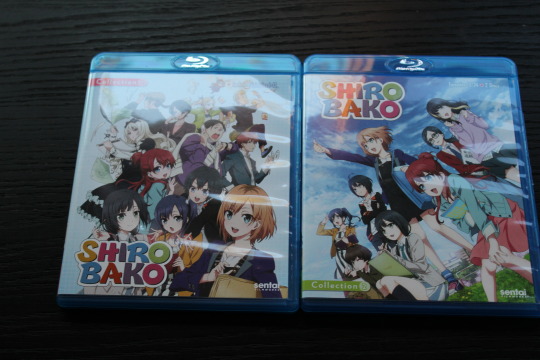
Shirobako: As impressive as this show is I wouldn't call the anemic release it got this year a must buy. A shame as the release and popularity of Shirobako in the West has aided in the significant change happening to the western anime fandom in recent years. The show opened a lot of eyes to the struggles inherent in creating anime, leading to a greater appreciation of the medium as a whole. I've seen it spur on people already present in a community branch out and diversify the type of content and critique that gets produced about the medium. These claims may be a bit unsubstantiated, but I’ve known a lot of people who after watching and enjoying Shirobako got a fire lit under them to really dive in and give back to the community/industry more than they had before. The knowledgeable and passionate members of our community are creating more content than ever that help breaks down the barriers between consumers and creators that appeared to exist for decades. Slowly we’re coming together to support these fans turned scholars and the medium of anime more and I can’t wait to see what 2017 brings to the table in this way. Unfortunately, as I mentioned earlier, my hyperbolic statements about Shriobako and what it may or may not have done for this community aren't reflected in this two-part Sentai Filmworks release (nor could they ever realistically be). With the show available to stream currently on Crunchyroll as well as Sentai’s oft-forgotten The Anime Network and its license nowhere near close to expiring this is a show you don’t need to run out and buy immediately. Frankly, if you’re still fanatical about the show you probably bought a bunch of character goods or the second pressing of the Japanese Blu-rays. I bought this domestic release an impulse buy because Amazon has decent pre-order discount and I had the leftovers of a birthday gift card. For everyone else who wants to buy I suggest you wait until Sentai inevitably releases a complete series set.

Maria the Virgin Witch: Another impulse buy, this the result of a Rightstuf.com holiday sale daily deal, but one I’m less regretful supporting early. What pushed me over the edge to buy it is because I am almost certain this gem of the Winter 2015 season will continue to be overlooked. It may be in part due to its title or the fact that a lot of anime fans tend to check out during the winter season. Either way, this show about a witch in an alternate history version of a European conflict is far more engaging and endearing than the one that aired in 2016 (though those are the only similarities between Maria and Izetta I swear). I want to talk about this show for the blog this year, so I don’t want to spoil too much. I will say that you can currently stream it through Funimation or Hulu and with Funimation’s partnership with Crunchyroll I’m sure it will enter their catalog as well next year (which would be a good time to release whatever I’ve written about it). Until then this show is destined to reach Funimation’s S.A.V.E. line in the coming years as a lot of good shows, unfortunately, do in this era of overwhelmingly huge anime seasons.

Otaku no Video: Probably the most impressive complete package I bought this year, Animeigo’s remaster of this classic OVA/Live-Action documentary by studio Gainax is pure shelf candy. I had slept on their remastering of Bubblegum Crisis, but I was enthusiastic in backing their second Kickstarter to give this essential commentary on fan culture the high-definition treatment it deserved. This limited edition comes in a solid chipboard box and includes an 180+ artbook on top of the additional audio commentaries, liner notes and three language tracks provided in the standard Blu-ray release. Though OVA itself looks better than it ever has the documentary, being not shot on 35mm film, looks decidedly more dated but less compressed than it did on the older DVD release. Robert Woodhead and everyone involved deserve high praise for the package they put together, and I would suggest any anime collector to grab the standard Blu-ray copy if they are the least bit interested. While I came from the generation of anime fans that grew after this project, I still find the topics it brings up relevant to fan culture today. There are numerous anime now that star “Otaku” now but the reasoning for almost all of those shows to do so is purely self-referential. The main character/characters are “Otaku” because the writer is one, and it gives them carte blanche to so how genre savvy they are to their majority otaku audience. Very few of these shows tackle the issues brought up about fan culture, and instead the "Otaku" character archetype has become so emblematic that it’s almost become a necessary cliche for a lot of writers to fall back on. So when I see shows that set out to address fan culture it makes me elated to watch. Shows like Genshiken, Welcome to the N.H.K. Comic Party and even Lucky Star to an extent come from a more genuine place. Whether this place is a more critical or celebratory doesn’t matter to me as it does to a lot of other fans and Otaku no Video clear cut between the fun-loving OVA and the far more sobering documentary may turn off some viewers. Sure both halves aren’t as seamlessly melded together as in later series but they are two halves of an essential whole, and I urge you to watch both if you haven't to gain the full experience.
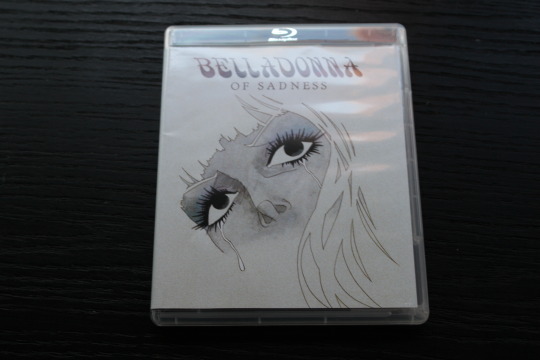
Belladonna of Sadness: I adore this film and relish in its beautiful restoration, but I’m at a loss for words with how to sell it to those not already in the know. Conceptually Belladonna of Sadness your straightforward rape revenge story but its presentation is anything but, not only in the realm of anime but animation as a whole. Belladonna is the final of the three Animerama films made by Osamu Tezuka’s Mushi Productions, a project that aimed to create more adult-oriented animation. It’s by far the shortest of the three films and, from what I believe is due in part to Tezuka’s lack of involvement, by far the most serious. Still, it shares the trilogy's real sense of wanting to experiment with animation on top of showcasing more mature storylines. Belladonna tale is shown through ornate watercolor stills, their elegance worthy of presenting in any art gallery. Despite showcasing limited animation for an animated feature the use of these still images through cinematography manages to make its tale no less poignant. However, in movement Belladonna is a surreal journey unlike anything on celluloid. The closest comparison I have are some of the films of Ralph Bakshi but even the most psychedelic of his sequences appear far more grounded than Belladonna’s phallic parade. The use of color and sound in these moments would be electrifying by themselves, but given the stationary nature of the film these energetic and unearthly sequences stand out even more. Despite all my praise, I understand that not everyone is as willing as I am to watch a 1970s, experimental, anime rape-revenge flick that is made up of mostly watercolor paintings let alone run out to purchase it. Luckily Amazon has it for streaming for Prime members so if you’d like to try it before adding it to your collection or just want to watch something daringly different be my guest.

Gundam Thunderbolt: In a year where Nozomi was putting out a Gundam release every month, fans of the long time mecha franchise, such as myself, were downright spoiled for choice when it came to collecting the series on home video. If I was a more die-hard fan I could have made a list consisting of almost nothing but Gundam titles, but I decided to have one release represent the franchise this year. I could have chosen traditional favorites such as Zeta Gundam, 0080 War in the Pocket or Char’s Counterattack. The oft-maligned ZZ Gundam or underrated series like Victory Gundam and After War Gundam X, surprising newcomers in Gundam Build Fighters and Gundam Build Fighters Try are also appealing buys. The glorious trainwreck known as Reconguista in G was at points calling my name to defend it here and if I really wanted to send I could have even chosen the excellent adaptation of Gundam: The Origin which came in some lavishly designed art boxes. However, if I had purchased all of these this year, even taking advantage of every sale and discount possible, I’d have been downright broke. Besides, I have a much better candidate. Gundam Thunderbolt December Sky, the compilation of the previously released four episodes, is probably the biggest piece of fanservice anime I’ve seen so far this decade. From the action choreography to the mechanical design and fluid animation all nestled in a dour military plot where neither side is the clearly in the right: This is the stuff of Gundam fans' dreams. Thunderbolt demands to be viewed in the highest definition possible, its excellent jazz soundtrack and overall sound design pleading for an appropriate surround system and this minimalistic Blu-ray release doesn't disappoint on that front. Where it does, however, is in the included dub. A dub little to most Gundam fans, especially those willing to import a Blu-ray movie, but after coming off one of the best dubs this decade, Gundam Unicorn, this is a real letdown. I’m sure this will still go over well when this eventually airs on Toonami, but I think this could have been casted a lot better. As of this writing, Gundam Thunderbolt isn’t legally streaming anymore, but hopefully when the planned second season comes out, the original will be made available either through streaming or a domestically released Blu-ray. It may be too much to ask most people to shell out for, but this right here is one of the best looking series this decade. Truly a high point for anime and animation in general. Plus one of the leaflets included in this box announces the Japanese release date for the Mobile Fighter G Gundam Blu-rays, which means they can’t be too far out from releasing domestically. I can’t wait to experience that beautifully godawful dub again, this time in high definition.

The Girl Who Leapt Through Time: Shinkai’s first non-franchise film initially came to the West with far less fanfare as his name carries now. Sure there were fans of Digimon Adventure: Our War Game! And One Piece Film 6: Baron Omatsuri and the Secret Island but the cultural cache behind the director's name hadn’t exploded yet. The Girl Who Leapt Through Time changed that and probably lead to Funimation’s decision to pick up the rights and heavily market his next film Summer Wars, a film which increased his level of notoriety to the point where people began calling him “The Next Miyazaki”. While still beloved post Summer Wars, The Girl Who Leapt Through Time had the unfortunate distinction of being one of the last anime Bandai Visual had licensed before they closed up shop. The film’s popularity combined with the small print run the Blu-ray received lead to massive price gouging on the secondhand market even for the more readily available DVD copy. Having already acquired the rights to Summer Wars, Wolf Children, and the then upcoming The Boy and the Beast it seemed clear to everyone that a Funimation relicense of this film wasn’t far off. In the meantime, many in the collecting community decided to purchase the frankly stunning South Korean Blu-ray set, though others including myself waited for a far cheaper domestic copy. I bought the standard release although Funimation released a limited edition version as well that I hear doesn't compare favorably when up against the previously mentioned South Korean release. Either way, this major film from a now well-established director has finally been made available again so it can reach the wider audience he has now. Funimation’s release comes with a number of extras on the disks the most valuable being the two interviews with Hosoda. The Girl Who Leapt Through Time might not be in my upper echelon of anime films, but it’s certainly one I enjoy on occasion, even with my general lack of interest in time travel and I'm glad to have it back in my collection in an affordable higher fidelity.

Dai-Guard: In this modern era of anime where new giant robot shows, outside Gundam, are infrequent it sure was kind of Discotek Media to redistribute this forgotten title in the genre. Imagine if events similar to those in Neon Genesis Evangelion occurred except that N.E.R.V. was not a ludicrously well-funded organization and instead had a budget similar to many of our real-life underfunded government organizations. Yes, the angel-like, amorphous threat known as the Heterodyne have returned after humanity's destructive confrontation with them twelves years prior but the only weapon capable of defeating them, the robot Dai-Guard, has seen better days. Now used as a mascot for the military Dai-Guard is barely able to make it through a battle without falling apart. This somewhat more comedic take on alien lifeforms set to destroy earth is one of the many things that set Dai-Guard apart from the many anime the share its premise. Unlike a lot of those anime, however, Dai-Guard is piloted by three people and their conflicting personalities and interpersonal stories, along with those of the rest of the 21st Century Defense Security Corporation add a lot of the flavor and weight to the series. The ensemble cast is what makes Dai-Guard more than your average giant robot show and anyone who's been a fan of office comedies, both in and outside anime, in the past decade will find a lot to enjoy here. Dai-Guard itself, while not the most memorable robot in anime history, is well designed and its signature weapons lead to some very well done fights. This show's more light-hearted tone acts as a nice reprieve in between watching more heady programming, for example, I decided to give this show a rewatch after watching Casshern Sins, and it worked wonderfully as a palate cleanser. As always Discotek does an excellent job maintaining the quality of the original release as well as shipping it in solid packaging. The original dub from the ADV release is here and is on par with what they usually produced back in those days. Overall Dai-Guard isn’t the flashiest show, but much like its titular robot it manages to hold itself together to deliver a satisfying punch to fans of a currently underserved genre.
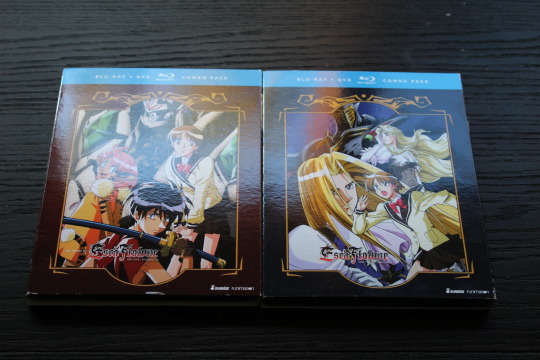
The Vision of Escaflowne: There was and still is a lot of drama in the anime collectors community surrounding the re-release of this well-loved anime from Sunrise. Funimation’s successful Kickstarter to redub the series was already showing warning signs before funding ended and their handling of the aftermath left a lot of people with a bad taste in their mouths. Needless to say, I doubt they’ll consider using crowdfunding again. I was unable to back the project and therefore I wasn’t privy to a lot of the discussion that took place about it. From what I managed to glean, unfortunately, it looks like an actual resolution hasn’t been met which is a shame that will continue cloud this release. Escaflowne was a huge deal in the western anime fandom upon its initial release and while it’s time in the limelight isn’t as constant as its contemporary Cowboy Bebop it is by no means a show that has aged poorly. Sunrise did an excellent job remastering this title in the Japanese release a few years ago, and the show has never looked better. I’m a bit biased toward the style of the show, being a huge fan of Nobuteru Yuki’s character designs since Chrono Cross, and when you add giant robots into the mix, you have a show that hits me right in the sweet spot. Top it all off with one of Yoko Kanno’s most celebrated scores, and you have a series poised to remain a staple in the western anime fandom for decades to come. As far as the new dub is concerned, it is certainly more up to the standards of new anime dubbing than the original, included with Bandai’s release. I never had a fondness for the original, so I can’t say I miss it. Nevertheless, I’ll still be sticking to the original Japanese for this show, unlike so many other Sunrise shows from this period. If this new dub is capable of bringing in more modern fans to enjoy this classic, then I am all for it supplanting the old one. I’m a bit disheartened that due to the new dub Funimation decided to split the series initially like they do with a lot of their newer acquisitions of similar length. They could have charged the combined price and kept everything in one box, but I guess that’ll happen when this show gets reprinted for their Anime Classics line. In the end, I’m for more people viewing this stunning show however possible either through purchasing these physical sets or streaming through Funimation and hopefully Crunchyroll sometime this year. Despite all of the mishegas, I’m glad to add this series again to my collection. However, I decided not to purchase Escaflowne: The Movie. The movie itself is an odd duck, being a pseudo-compilation movie that also alters many characters and events not just for the sake of time. I tend to find a lot of these movies rather substandard, the exception being The Adolescence of Utena which I have grown to enjoy over time and will be pleased to repurchase along with the rest of the series on Blu-ray in 2017. As for Escaflowne: The Movie I may pick it up for the sake of completion but only further down the road when it’s discounted.
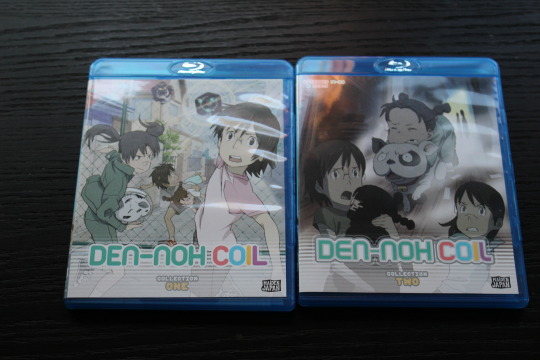
Den-Noh Coil: 2016 was going to be the year that I began importing a lot of anime as domestic licensers were either slow or unable to distribute the shows I wanted. Many these series were made available by Australian publisher Siren Visual, whom I’ve purchased from before to get my copy of Welcome to Irabu’s Office. Luckily Sentai Filmworks stepped in to begin distributing a handful of Siren's catalog in Region A including this one (now if only they or anyone would license Monster or Kaiba). Den-Noh Coil had been a show that struck a chord with me when I found it online in 2008 and was one of the big things I shared with my college anime club when I was asked to run nights. I held out hope that the show would officially available in English, but that wish and the little fanfare the show received subsided as the years continued. It’s a shame the series and its talented creator Mitsuo Iso haven’t become household names, and I’m hoping this late release can help restart the conversation about both. What surprised me most about this release from Sentai Filmwork’s Maiden Japan imprint is that they decided to dub it, and I honestly think it isn’t half bad. I rewatched the first handful of episodes dubbed and while North America’s limited anime VA talent limits it (as it does almost every modern dub) I’d hazard to say it tops Maria the Virgin Witch’s for my personal choice for best dub of the year. Unlike Maria’s I find the dubbing of this show far more important as I genuinely think this is a good show for younger children. The kids in this show look and act like kids and while it gets a bit dark in places there is nothing here that I think would frighten kids more than the cavalcade of horrors I saw growing up watching Don Bluth movies. I also see this show as a good candidate to ease your older friends and family into anime as there isn’t anything here I’d consider objectionable or embarrassing. Besides, a lot of the concepts in this show are moving far closer to the realm of possibility than they were a decade ago. Wearable computers, virtual reality and the omnipresence of technology and how it meshes with where we live are far more relevant topics than they ever were in 2007 due to how tangible all these ideas are to us now especially with kids who grew up only knowing smartphones and tablets. I’m glad I got to revisit this show recently, and I’m hoping more people do in the coming years so I can talk about it with someone. It’s only available to stream through The Anime Network for now but hopefully, some other site (Crunchyroll) will be able acquire it as well.
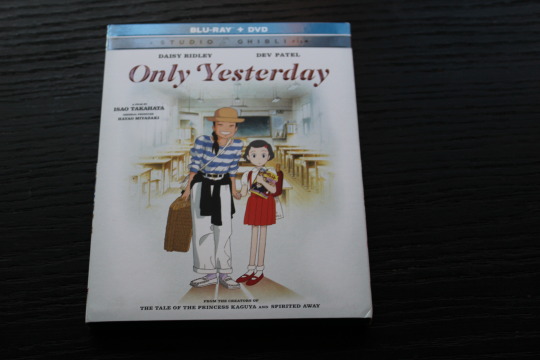
Only Yesterday: It makes sense that this would be the last of the major Studio Ghibli films to see release in North America. A movie about the growing ennui of a late 20-something business woman isn’t something you can easily sell to kids, especially when there isn’t a randomly inserted fantasy sequence such as with the similarly tonal Whisper of the Heart. Still, as I hasten to reach the age of our protagonist Taeko Okajima I’ve only found this film more relatable and it has managed to climb the ranks of my personal “Ghibli Hierarchy”. There was a lot of buzz around this Disney dub starring The Force Awakens' lead Daisy Ridley, but I can’t say I’ve listened to this one yet. I can assure you that the mixed reactions I've heard and read from a lot of people haven't affected my decision to do so. My reasoning for not listening to it is rather simple: I don't want to watch a film grounded in 1980s Japan with English voices. The dub is there for those who want it, and if it manages to get more people to see this movie, then it was worth making. Only Yesterday is a fantastic film worthy of placement in your collection alone, but the over 40-minute making-of documentary included in its extra features make it a must buy for anyone interested in animation production or Studio Ghibli. Not only does this cover a lot of the movie's unique production aspects of the film but the culture of Studio Ghibli at the turn of the decade. Being filmed around Only Yesterday’s 1991 release this is relatively early in the studio’s life, so it’s an excellent snapshot of this period. Being one of Takahata's films we see a great deal of him and his worth ethic both in animation directing and with running the studio, something we, unfortunately, don’t get a lot of due to the cult of personality surrounding Hayao Miyazaki. Of course, Miyazaki is prominently featured here, as well, and this being the early 90s he’s relatively less cynical. Being able to own this documentary that I’ve watched for a number of years is great, and I’m thankful the folks at Disney went out of their way to acquire it again for this release. It's a sizable contribution that makes an already great package truly stellar.
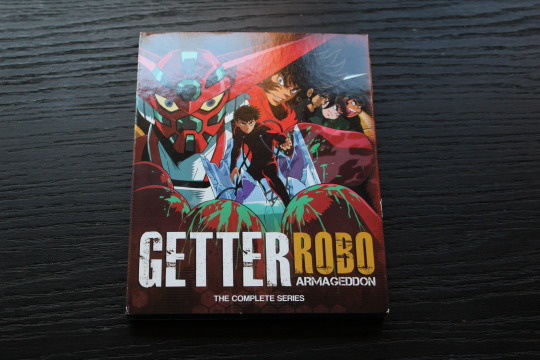
Getter Robo: Armageddon: I tend to have horrible luck when it comes to purchasing old media. Most times I buy something that’s long out of print it gets announced for a re-release within the next few weeks. Getter Robo: Armageddon would surely have been another one of those cases had I not checked Facebook to see Discotek Media’s announcement. I used to show this one as well in my college anime club, and a lot of the folks who were Gurren Lagann fans ate it up. For months I had been waiting for this action-packed OVA to be released in high definition, getting jealous of those who attended summer cons grabbing and early print copies. This gritty, high-octane giant robot show is an enjoyable romp from beginning to end. The remaster not only makes the colors pop, but the improved sound makes all the action scenes for me, that and most of the episodes starting with the second opening HEATS doesn’t hurt either. This entire series scratches that itch for hot-blooded fun and looks marvelous doing it. I’m always happy to support a company like Discotek because time and again they release quality products and Getter Robo: Armageddon is no exception. After the anime crash in the late 2000s, I thought a company like Discotek that only licensed older anime would be a flash in the pan. With every box set and movie, I buy from them I'm reminded how wrong I was in my assumption. Their 2017 lineup is already looking stellar and the fact they announce new licenses almost every other month shows how strong they’ve become.

Sword of the Stranger: You might wonder why I’ve taken a photo of the older Bandai release instead of Funimation’s recent reprinting. This is because despite the Funimation release getting a dub I didn’t feel the need to rebuy something I already owned on Blu-Ray. I’ve heard the dub is fair and the extra features are nice, but neither are spectacular enough for me to double dip so early. Nevertheless, I wanted to bring attention to this great action film’s re-release and if you read until this point in the post you know I’ve already spent my fair share on anime this year so cut me some slack. Sword of the Stranger one of the first names brought up when anime fans want to showcase a great action scene. The choreography the folks at Studio Bones nailed down here is outstanding and worthy of any action showcase. Fans of Fullmetal Alchemist: Brotherhood should be elated in finally getting access to this movie again as that series owes a lot to the style of action created for this film. Not only that but the film as a whole is a solid feature: a simple samurai story told well. There isn’t anything revolutionary going on here plotwise, and the characters are familiar archetypes though not to a fault. It isn’t trying to deconstruct its themes and characters for critique. Rather it comes off as a slick action movie that effortless falls into the greater chanbara canon. I appreciate this film's simplistic approach. It makes for easy sharing with friends and family who don’t usually watch a lot of anime. Sometimes all I want is a good self-contained action movie and Sword of the Stranger delivers and then some even a decade later. My only reservation about picking this one up now is that somehow Funimation failed to include subtitles for the Chinese dialogue, something included in the Bandai release I own. I'm hoping that with the release being so recent and the mistake pointed out that it will be fixed in newer pressings and that those who picked it up early can get exchanges. Maybe 2017 will be the year Funimation also revamps its attitude toward quality assurance? Here's hoping because I'd hate for a great film like this to be dragged down by an easily fixed mistake.
By now I’ve written more than enough about the anime on home video (re)published in 2016. Not only that but some well-beloved classic titles have already been announced for release (again) next year. Featuring plenty of Gundam, Revolutionary Girl Utena Blu-Rays, Urusei Yatsura: Beautiful Dreamer, Captain Harlock: Arcadia of my Youth and if we're lucky more popular Sunrise shows. 2017 looks to be an even better year for those of us who relish in collecting disks and I'll be there, my bank account willing, ready to enjoy it.
See you next week.
#the vision of escaflowne#only yesterday#gundam thunderbolt#the girl who leapt through time#shirobako#maria the virgin witch#den-noh coil#sword of the stranger#da-guard#gundam#getter robo armageddon#getter robo#belladonna of sadness#otaku no video#anime
3 notes
·
View notes
Text
Game of the Year 2016
With 2016 in the books, it's time to look back at some of the strongest games of the past twelve months. Developers continued upon the success of 2015, as 2016 once again had tons of high quality releases to be considered. Usually each year has three or four games that are held in higher regard than the rest, but this year this could be said about so many more games than that. So, let's jump in!
As with always, the rules are as follows:
The game must have its final retail release in 2016. Thus, anything in an alpha/beta state or Steam Early Access does not qualify.
In the case of episodic games, they must have their final episode delivered in 2016 to make the list.
While this list is comprehensive, I haven’t played everything. The Last Guardian and Owlboy came out too late in the year while I was already catching up on other games. Hyper Light Drifter and Darkest Dungeon are two others that unfortunately are still in the backlog.
Most importantly: the game has to be really good. No-brainer there.
Honorable Mentions:
Ultimate Chicken Horse - Unique local multiplayer will cause you to create traps and challenges as you do your best to conquer levels while at the same time making sure your friends cannot.
Asemblance - The twists and turns that build in this 90 minute psychological thriller do a fantastic job keeping the player on edge.
Doom - An in-your-face thrilling campaign and great resurgence for a franchise that definitely needed the kick.
10. Final Fantasy XV (Square Enix - PS4, XBO)

After a decade of development, the seemingly mythological RPG finally released in 2016. The most recent Final Fantasy is a potpourri of ideas and genres where the stitching can clearly be seen, but the sum of its parts help to create an enjoyable experience. Square Enix's ambition with this game is something to be appreciated, as they certainly spent a lot of time trying to create something unique. The battle system is engaging and fun, and this succeeds most during some of the towering beast battles that take place in the game's tucked away dungeons. There's a lot to see in this world, and the team did will to allow the player to always return to explore this sandbox even during pivotal story sequences later in the game. The game's core cast is also quite strong, as the group of four may not each appeal to you at first, but each have their time to shine during the story.
9. Firewatch (Campo Santo - PC, PS4, XBO)

The thing to take away the most from Campo Santo's debut is that this is an honest tale of how humans react to situations. The game starts with an effective "choose your own adventure" type opening that shows people go through adversity no matter what you try to do. The world that artist Olly Moss helped bring to life is vibrant, and Chris Remo's soundtrack sets the tone perfectly as you wander the forest. Most importantly, the game builds a solid relationship between two characters that haven't even met face-to-face yet as they both oversee their respective areas. Some games spend dozens of hours trying to build this type of character and emotion, but Firewatch is able to do it with success in the four hours you'll spend in the wilds.
8. Virginia (Variable State - PC, PS4, XBO)
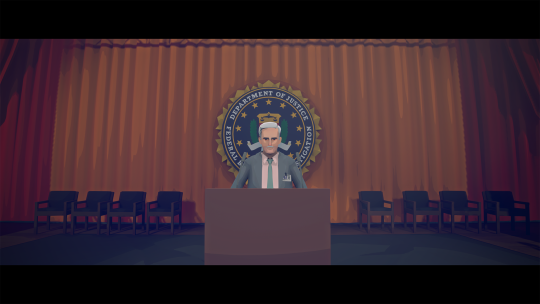
A title that flew under the radar for most, this mystery tells a fascinating story without even saying a word in the journey. The story follows a character that has just been accepted into the FBI to help investigate a missing person, but the way the story is told makes the ride a great one. Dream sequences and time jumps create a mystique to the narrative that would be hard to appreciate as just a linear timeline of events. It's one of the few story based games that makes you want to hop immediately back in upon finishing to see what you missed as everything unfolds. There isn't quite much like it, and that helped it truly stand out.
7. Inside (Playdead - PC, PS4, XBO)
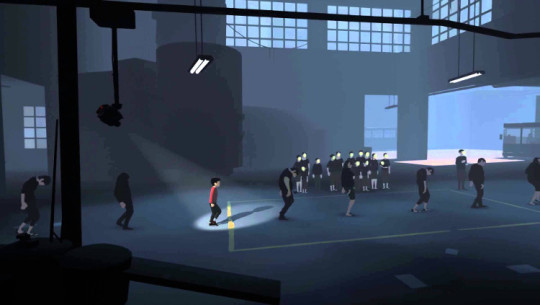
Playdead's second game may look similar to their breakout hit Limbo, but it's very much a tale of its own. While you are dropped in a mysterious world as a child with no explanation or tutorial, the game does a fantastic job of showing you the ropes through trial and error from the beginning. The graphic ways your character can die help build tension while you sneak around guards, dogs, and other hazards to try to piece together what's going on. As with Virginia, there isn't a word spoken throughout the entire experience, but the world here builds itself with the environment. Things can be pieced together in your surrounds, both relating to the story and how to solve the next puzzle. The amount of detail that Playdead put in to what seems like such a tiny package is mind-boggling, as the setting is fleshed out in an eerie and amazing way. The end may leave you with a few questions, but sometimes that's the way it should be.
6. Titanfall 2 (Respawn - PC, PS4, XBO)

The original Titanfall was an entertaining multiplayer game, but it didn't seem to catch on with enough people and left others wanting single-player content. Respawn made good on this in the sequel, by creating one of the most surprisingly evocative campaigns to come out of a first person shooter in recent memory. In all media, creators often struggle to make robots and mechs seem like real characters, but Titanfall 2 succeeds in creating a strong personality with your titan, BT. Small quips back and forth between the character and BT are engaging, and you even get the opportunity to slightly guide the conversation with dialogue trees that don't impact the story but lead to personalized conversations. That isn't the sole success of this game though, as the combat is a blast. Movement is quick, and the ability to run and jump on walls leads to intense combat in both single and multiplayer. While Titanfall 2 wasn't the standout FPS on the sales chart, it was certainly the most enjoyable of the big three this year.
5. Superhot (Superhot Team - PC, XBO)

This unique project has been intriguing people for years ever since it was initially available as a web demo three years ago. It's an FPS with a mechanic you haven't seen before the genre: time only moves when you move. When you enter a room, you'll see all the enemies and can plan your attacks. However, the second you move your body (or even your head), the other characters and objects will move. If an enemy has a gun, you're able to stop the second he pulls the trigger and quickly figure out where to move to ensure you don't get shot. It's a mechanic that brings depth to every situation you encounter and you plot out where to move and when to attack. The game's presentation also helps set it apart, as the menus will create fake IRC chat rooms and even other games (what's up Tree Dude, the true GOTY) to help build its world. There truly isn't anything like Superhot, and this is definitely a team to watch going forward.
4. Uncharted 4: A Thief's End (Naughty Dog - PS4)

It's a testament to the quality of games this year to say that one of the best games in the highly respected Uncharted series didn't make the top 3, but that doesn't make it any less of a game. Nathan Drake's swan song is one to remember, as Naughty Dog yet again created a wonderful story with both familiar and new faces. While the treasure is always the story, A Thief's End does a great job of giving Sully, Elena, and Sam each their time to shine throughout the story to further build their relationship with Nate. It's likely the best that the Nate and Elena story has been, especially after some of the questionable twists in that arc previous games have taken. Needless to say, the game is beautiful and yet again is the hallmark of power for a Playstation platform. The key set piece moments are there, and this is showcased with the brutally impressive truck chase sequence where you will constantly be left saying "Did I just pull that off?" While it's a shame to walk away from Nate now, he's certainly had his time to shine, and it was one hell of a ride.
3. Overwatch (Blizzard - PC, PS4, XBO)
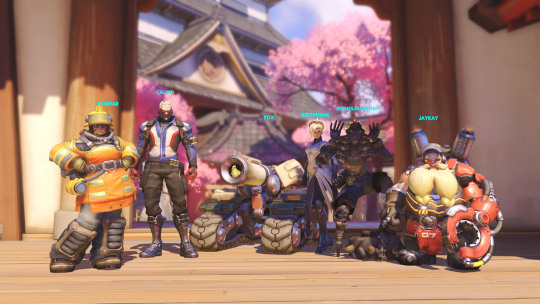
Stop me if you've heard this one before: Blizzard took a genre that typically is difficult for new players to penetrate and made a game that was easy for anyone to hop into. Well, it happened again with their hero team-based FPS: Overwatch. Using some ideas from the scrapped Project Titan, Blizzard created 21 (later 23) hero characters that each has their own unique abilities and play style to help conquer objectives. Teams of six work against each other under various conditions to help achieve a single objective. Certain heroes work well with each other, while some can be used to counter opposing heroes. Plus, to keep it simple and allow games to swing, you can change your hero anytime after a death, so strategies can adapt on the fly. Above all else though, Overwatch does a wonderful job in easing players in by simplifying their stats and not necessarily making it about your kill/death ratio. Don't be confused, if you aren't helping your team, you aren't going to win, but not constantly knowing that you've died three more times than you taken down opponents helps a player's morale. The game has a style all its own, and with the continuing free updates Blizzard has been making through the year, it's going to be great to see where this game goes down the road.
2. Hitman (IO Interactive - PC, PS4, XBO)
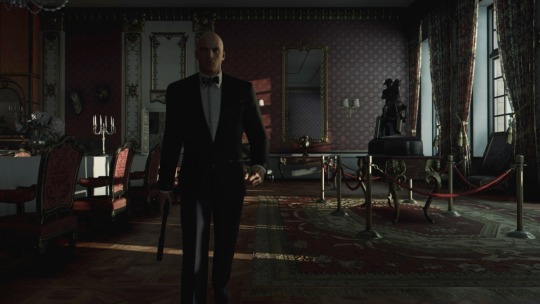
There is no game more surprising in 2016 than Hitman. It was one of those games with a lot stacked up against it: the most recent Hitman was mostly disappointing, the business model changed to episodic at the last second, and everything just seemed like a mess. However, once players got their first full episode in Paris, it was clear that something special was being made. Each episode of season one featured a new locale with two story targets to take out, but that was only just scratching the service. As with most Hitman games, there are multiple ways to go about achieving your goal, and this is done wonderfully here as you explore and find breadcrumbs of meetings and interviews that can help disguise you to take down your enemy. Optional targets and user-created missions helped give every map life, but the true shining gem is the elusive target feature. Every other week, IO adds a character to a map and you need to find a way to take them down, but you only get one chance. Think of it as Spelunky's daily challenge, where everyone has the same mountain to climb but only one crack at it. Even your most thought out plans will lead to failure, but a lot of the fun in the experience is quickly adapting when everything is hitting the fan. Hitman was a question coming into the year, but the only thing people are asking themselves going into 2017 is how soon season two will be here.
1. The Witness (Thekla, Inc. - iOS, PC, PS4, XBO)
youtube
In the Witness, you are presented with hundreds of puzzles that just require you to draw a line from the beginning of the panel to the end. That sounds pretty simple, right? Well, it's far from that. Jonathan Blow created a masterpiece with intricate puzzles that will test the limits of your brain to get through all of them. When you begin the game, the first puzzle just has you draw a straight line, which is a surprisingly simple yet great way to introduce you to each set of puzzles. The game allows you to free roam, but every time you encounter a new set of puzzles, the first panel will show you an incredibly bare bones puzzle to teach you the logic of that area. Using that knowledge, you'll need to apply it as the puzzle in that section get larger and larger. As you move through the world, some puzzles will even take ideas from other puzzle and mix them together, which leads to some heavy thinking to push forward. The exploration is also a wonder, and this isn't just because of the mysterious and beautiful world that Blow's team created in the game. Sometimes you will come across puzzles with symbols that seem foreign and unsolvable. However, after tackling an area and learning a new mechanic, there isn't a better feeling that realizing you can find that one-off puzzle and solve it.
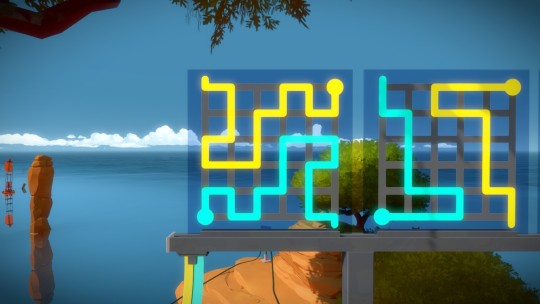
The Witness goes much deeper, but spoiling the surprise and twists in game play would simply just take away from it. The Witness is not easy, but it is so rewarding to figure out the solutions and intricacies of the world on your own. There is one specific moment at the end of the game that will make you feel like an actual genius if you are able to complete it, and there was not greater moment in games this year than that. Sometimes, the simplest of ideas can lay the groundwork for something much deeper, and that's exactly what the Witness does. The journey wasn't always easy, but looking back, it's easy to wish you could forget all of the mechanics so that you could learn it fresh again. The Witness is one of the strongest games of recent memories, and you owe it to yourself to try to conquer the puzzles found within.
#goty 2016#the witness#hitman#overwatch#uncharted#superhot#titanfall 2#inside#virginia#firewatch#final fantasy xv
4 notes
·
View notes
Text
My First Game Jam: Winter 2017
Here we go again!
Over the next two weeks (January 7th - January 21st) I'll be making a game for My First Game Jam: Winter 2017. This will actually be my second game jam, so please, nobody call the police. In spite of the title, the jam invites complete beginners and experienced programmers alike, so long as the latter try something new. I'm still a beginner, but I'll honour that agreement and strive to try new things this time around. Aside from learning new things and making a new kind of game, one of those new things I'll be trying is to keep a development blog. This will be it.
The first game I made was "Boyle and Bubble" a very short little SHMUP for GBJAM 5, which spanned the first ten days of October 2016. It's incredibly simple, but I learned a lot in creating and finishing it; I'd fooled around a little with prototypes before, but never "released" anything that could be called a game. Before I get started on this next game I'd like to take note of what I learned in my first game jam, and keep it in mind going forward.
No matter what, just start
Get going! Boyle and Bubble grew really organically, and I'm not sure if this is because I got very lucky, or if I it was because I didn't have any grand designs in mind to begin with, and just played around and let it happen. I built a game around realistic restrictions I observed about my own skill and the conditions of the jam; the art had to be simple, I am terrible at making engines for platformers, and it had to feel like something that could have existed on the Game Boy. It also helped that GBJAM 5 happened to fall in the run up to Hallowe'en, so there were a lot of pumpkins and ghouls and skellies flying around social media. I realised a SHMUP would make movement easier on me, and I idly started to pixel a small cutesy witch.
From that point, everything came together pretty simply -- a witch typically has a cauldron and casts spells, so the enemies became elemental, and the player had to mix up elements in her cauldron to come up with new magic. Granted, this is an incredibly simple premise, and it didn't birth a ground-breaking new type of gameplay, but going in without a colossal set of expectations and goals was really liberating. There was only a week to work with, and a simple concept like that seemed to work.
Releasing feels good
Most of the reason I'm taking part in this jam, aside from to learn something new, is quite frankly to release something, and get that buzz. I still have lots of prototypes lying around, but since the end of GBJAM 5 I've been committed to working on a new game that I think has a manageable scope that I still know will take me a good deal of time to complete. Sometimes I can feel myself burning out working on it, and I'm eager to find reasons to go back and work on other projects -- maybe now I know this, I can do this better, or maybe so-and-so project didn't fail that badly, if I just try something like this... So a game jam is a great compromise. A set period of time when I can focus on something outwith my long term project, and happily draw a line under it when the deadline comes around. I'll get back to my larger project, but I'll have that wonderful Game Finished And Released feeling.
Plan small, and then resmallerise it
Talking about the size of my current project brings me to the next point - size. Planning simple and planning small are key. Certain ideas lend themselves better to jams than others. Boyle and Bubble in some ways suited a jam really well, but less so in others. In the game you can play now, there's a singular level, but I spent so much of the week programming and making consistent the elemental combination system and plugging in all the different spells that I didn't have time to build all the levels and enemies and bosses necessary to showcase those spells. All of that code exists in the game, but playing through the only level on offer, you'll never see it. I had to settle for letting you choose to use two elements separately, or combine them depending on the circumstances. My plan was small going in, but even so, planning smaller still wouldn't have hurt.
Prototype core mechanics first
This is going to seem like a silly thing to even have to say, but I have to say it, if only to myself. I talked about how Boyle and Bubble grew organically from the restrictions and spriting the player character, but even that was probably a mistake. It helped that the Game Boy limitations meant my art was never going to have to be super complex, but a square box would have suited for pretty much every enemy in the game until much later.
More importantly, Boyle and Bubble had no failure condition for the majority of development, so "playtesting" really was just to see if enemies behaved according to plan. The player couldn't take damage from enemies or projectiles, so there was no incentive to move evasively -- a pretty core mechanic in a SHMUP, second only arguably to, you know, "shooting 'em up". Since there was no threat, playing the game only began to feel like actually 'playing a game' much later. I floated through the levels and saw how movement patterns worked and how projectiles behaved, but the feel of the game was missing for a long time. Had I been playtesting with player death for a great deal more of the development, the game might have felt very, very different earlier on, and probably for the better. The simplest form of the final game is what should be built first.
Budget time around the smallest features with the biggest impact
Hit points! Damn it! Closer to the deadline for GBJAM 5, I started doing my best to budget my time accordingly. With two days to go, I was taking a look at my "development log" (notepad file filled with annotations like "FIX!!" and "this is bad, probably do this like this") and being pretty brutal about what to cut and what to prioritise. It's the reason why the game only features one level, limited enemies, attacks, etc. But even though this was good practice, I still managed to goof colossally.
With about 20 minutes until the deadline and the itch.io page all filled out and ready for the upload, I was almost finished, but had to choose between two things to finish. I'd wanted for a while to program in a three-hit HP system to make the game a little more lenient, but I also had no way to round the game out. There was a boss, and he had an attack cycle, and you could defeat him and he blew up, but then nothing happened. I knew what should happen -- Boyle should glide slowly over to the right of the screen, her adventure complete, fade to black, credits roll. That's how a game should end. So that's what I did. I shelved the HP system ("hey, at least the player can die and restart") and plugged in a way to take control from the player after the boss is defeated, float them over to the right side of the screen, and whipped up a quick credits reel. Boyle hovers up top and waves to you as the names scroll up, and then it boots you to the main menu. Fine! Good. But this was a mistake.
Considering how few people played the game, it really couldn't afford to turn people off quickly. Getting hit by an enemy and being told to restart is a pretty good way to lose patience with a game, I think, and not only that but the threat of taking damage persisted through the level -- the credits sequence was good for a few moments at the end of the game. It wasn't a good trade-off. I don't know that anybody else ever saw them. Four of the five comments people kindly left as feedback for the game reference how unforgiving it was to have a one-hit kill mechanic in the game. One even notes that they were disheartened to die in one hit the moment they encountered the boss.
The ultimate gut-punch here is that on the day after the jam ended I opened the project file back up and carried on tinkering. I'd planned on taking a break, but I couldn't get out of the habit after a week of working on the game religiously. I knew the game should have the three HP system, even before the feedback, so I looked into it. It turned out to be incredibly simple, and took me less than ten minutes to implement.
Don't neglect sound
Another small feature that would have dramatically changed the game was sound. In the run up to the game jam I'd read or watched something (I regret I can't remember whose advice this was) where this point was stressed -- not to neglect sound, because it makes such a big difference. I knew this going in, and told myself that there might be no music, but I would at least have time to whip up a few sounds in BFXR. In the end I cut sound as something to accomplish, and I wish I hadn't -- I went to the trouble of adding particle effects and little explosions and a couple of animations that sound would have really spiced up, even without music.
I wasn't particularly concerned with "winning" GBJAM 5, but I was surprised how well the game did in a few categories (visuals especially), but you can see from a quick breakdown of the categories that having no sound really made a difference. The best score you can possibly honestly give for a game with no sound is a middling one -- that's taking a generous view, with the approach that "well the sound wasn't good or bad", but I think really the score you give to a game with no sound is the lowest possible score.
I deprioritised sound in order to play to my (relative) strengths. I knew I could just about program the game, and I can make very simple pixel art, but with sound, I have no experience. In some ways maybe this wasn't such a bad thing, but again, there's a catch; immediately after the jam ended, I was surprised that people actually approached me over social media offering to give the game a soundtrack. I had thought of working on the jam as such a personal project (and knew well enough people from all discipline's loathing of being asked to work for free, or worse, for "exposure") that I made peace with the idea that if I can't do it, it won't be in my game. The generosity of strangers really caught me off-guard.
Don't neglect your health, either
Budgeting time is important to get your game finished, but you have to budget the time in the day to keep yourself going, too. I made some duff decisions on what to cut from the game, but I think in some ways they were excusable because it meant I finished the game. But I cut time out of my routines outwith programming that simply aren't sustainable -- I stopped running for that week and ate very badly, because it was easier than taking time out to cook smart meals, and an hour out for a run was an hour I could spend bugfixing. I was glued to my screen, and pretty much the only social contact I had was a stalwart friend who was practically responsible for safeguarding my brain and keeping me sane as I stared at code for hours and hours on end. This was okay for a week, I think, but I don't plan on doing it again, even for just the two week span of MyFirstGameJam.
Game development fridge magnet wisdom is actually really, really good
If these nuggets all seem incredibly familiar, I'm sure it's because they have been expressed (much more effectively) in a hundred other lists like this. Derek Yu's "Finishing a Game" probably covers everything here and more, and it's all really great advice. His book on Spelunky was also really insightful and helpful to read. Following Tom Francis's development of both Gunpoint and Heat Signature and learning from his "Make A Game With No Experience" series and dev logs helped me a ton, too. I probably couldn't cite all the sources that I try to keep in mind when fiddling around with a little prototype -- the almost zen koan-status game design wisdom of Miyamoto Shigeru, that one Mega Man X Sequelitis episode, Mark Brown's really insightful Game Maker's Toolkit series, and so many others. All this is really just to say Take Advice From Smart People, You Dummy.
Show people your game, and talk to other people that make games
This was the #1 thing learned -- show off your game on social media, and find other people making games there too. I dislike a lot about social media platforms and what fills them, but I met so many amazing people that were super supportive, and offered advice and feedback. Also, as a complete novice, everyone was like a mentor to me, even if indirectly; watching much more experienced devs create amazing games alongside my own efforts was much less off-putting than I would have thought, and actually just inspiring. It was really gratifying for some reason to see titles I'd seen in development on Twitter (Bob&Dob! Soulstice! Zero Star! Noru! Monster Buds! Zipper League Hockey!) appear as fully-fledged games on-site on the final day. Also, to reiterate an earlier point, Twitter was the medium through which people offered to pitch in with sound and music post-release. People coming out of the wings to support you is amazing.
If nothing else, game jams are the ideal way to get as many hands as possible on your work. Boyle and Bubble has only been downloaded something like 40 or 50 times, but this is way more people than would ever have played my first game otherwise. Feedback is incredibly important to learn lots of important lessons early on in any discipline, and jams really foster that. That was fantastic to experience, and I'm looking forward to it again.
With that said, My First Game Jam: Winter 2017 is well underway, and I have lots to do. Next time I post, a brand new baby prototype will have been born.
x"�1��\
1 note
·
View note
Text
Remote Learning? No Thanks. – The New York Times
Want to get The Morning by email? Here’s the sign-up.
Good morning. Virus hospitalizations are surging. The Trump administration will send more agents into cities. And desperate parents are thinking about home schooling.
The coronavirus is so widespread in the U.S. that many schools are unlikely to reopen anytime soon. Already, some large school districts — in Atlanta, Houston, Los Angeles, Phoenix, suburban Washington and elsewhere — have indicated they will start the school year entirely with remote classes. Yet many parents and children are despondent about enduring online-only learning for the foreseeable future.
So it makes sense that the topic of home schooling is suddenly hot.
Parents who never before considered home schooling have begun looking into it — especially in combination with a small number of other families, to share the teaching load and let their children interact with others. Some are trying to hire private tutors. One example is a popular new Facebook group called Pandemic Pods and Microschools, created by Lian Chang, a mother in San Francisco.
Emily Oster, a Brown University economist who writes about parenting, has predicted that clusters of home-schooling families are “going to happen everywhere.”
Of course, many middle-class and poor families cannot afford to hire private tutors, as my colleague Eliza Shapiro pointed out. But there is nonetheless the potential for a home-schooling boom that is more than just a niche trend among the wealthy.
Consider that the population of home-schoolers — before the pandemic — was less affluent than average:
Eliza told me that she thought many families, across income groups, were likely to consider pooling child-care responsibilities in the fall. Children would remain enrolled in their school and would come together to take online classes in the same house (or, more safely, backyard). In some cases, these co-ops might morph into lessons that parents would help lead.
As for high-income families, they may end up having a broader effect if a significant number pull their children out of school and opt for home schooling. “We could see a drain on enrollment — and therefore resources — into public schools,” Eliza said.
As Wesley Yang, a writer for Tablet magazine, asked somewhat apocalyptically, “Did public schools in major cities just deal themselves a deathblow?” And L’Heureux Lewis-McCoy, a professor at New York University, recently told the science journalist Melinda Wenner Moyer that any increased privatization of education was likely to “widen the gaps between kids.”
It’s too early to know whether home schooling is more of a real trend or a social-media fad. But the U.S. is facing a dire situation with schools: Remote learning went badly in the spring. The virus continues to spread more rapidly than in any country that has reopened schools. And, as Sarah Darville points out in an article for the upcoming Sunday Review section, the federal government has done little to help schools.
No wonder parents are starting to think about alternatives.
How can school districts respond? Jay Mathews, a Washington Post education writer, has a suggestion: Superintendents should abandon trying to devise a single solution for an entire school system.
“Let principals and teachers decide,” Mathews writes. “They know their students better than anyone except parents, who would just as soon get back to work.” His column includes specific ideas he has heard from teachers.
THREE MORE BIG STORIES
1. The biggest bet yet on a vaccine
The Trump administration announced a nearly $2 billion contract with Pfizer and a smaller German biotech company to produce a potential coronavirus vaccine. The contract is the largest yet from Operation Warp Speed, the White House program to fast-track a vaccine.
The government won’t pay the drugmakers until the vaccine gets F.D.A. approval. “It’s like a restaurant reservation,” explained Noah Weiland, who covers health care for The Times. “You pay for dinner when you eat it, but you’ve got yourself the prime table in the restaurant instead of having to wait in line.” If the vaccine works, individual Americans would receive it for free.
2. Where the virus is under control
No region of the United States suffered a worse virus outbreak this spring than the Northeast — but few places have managed to bring it under such good control in the last couple of months.
“It’s acting like Europe,” Ashish Jha, the director of the Harvard Global Health Institute, said. After cases and deaths surged in Europe and the Northeast, both places responded with aggressive lockdowns and big investments in testing and tracing efforts. Residents have also been willing to follow public health advice — wearing masks, staying out of confined spaces and more.
In other virus developments:
3. Trump sends more agents to cities
The Trump administration says it will send hundreds of additional federal agents into cities to confront a rise in violence. The plan calls for sending about 200 more agents to Chicago, 200 to Kansas City, Mo., and 35 to Albuquerque.
In Portland, Ore., early this morning, federal officers fired tear gas near the city’s mayor, Ted Wheeler, who had joined demonstrators outside the federal courthouse. Coughing and scrambling to put on goggles, Wheeler called the officers’ tactics an “egregious overreaction.”
Media watch: Sean Hannity, Rush Limbaugh and other conservative pundits have seized on the Portland protests as a pro-Trump rallying cry.
Here’s what else is happening
After ordering the Chinese Consulate in Houston to close, the State Department accused Chinese diplomats of spying and attempting to steal scientific research.
China began what it hoped would be its first successful journey to Mars, launching equipment on a voyage that will last until next year.
The House voted overwhelmingly — with 72 Republicans joining the Democrats — to remove statues of Confederate figures and white supremacists. Mitch McConnell, the Senate Republican leader, is likely to block the measure.
President Trump again sought to showcase his mental fitness by repeatedly reciting what he said was a sample sequence from a cognitive test. “It’s actually not that easy, but for me, it was easy,” he told Fox News.
Employees of Hearst Magazines — the publisher of Cosmopolitan, Harper’s Bazaar and Marie Claire — described a toxic work environment, including lewd and sexist remarks by the company’s president, Troy Young.
Lives Lived: “My analyst told me/That I was right out of my head.” The woman who wrote and first sang those memorable lines was Annie Ross. Best known as a member of Lambert, Hendricks and Ross, probably the most successful vocal group in the annals of jazz, she was also, later in life, a movie actress and a cabaret mainstay. Annie Ross died at 89.
By 2070, the extremely hot zones that now cover less than 1 percent of the Earth’s land surface — like the Sahara — could cover almost 20 percent. Water sources would vanish. Farms would go barren. And hundreds of millions of people would be forced to choose between flight or death.
“The result,” writes Abrahm Lustgarten in a new story for The Times Magazine, “will almost certainly be the greatest wave of global migration the world has seen.”
The Times Magazine and ProPublica have modeled what that migration could look like. “Northern nations can relieve pressures on the fastest-warming countries by allowing more migrants to move north across their borders, or they can seal themselves off, trapping hundreds of millions of people in places that are increasingly unlivable,” Lustgarten writes.
The article is part of The Magazine’s climate issue, which also includes pieces on Argentina’s fearsome thunderstorms; the teenage activists leading the climate change movement; and the Louisiana communities that may be lost in a plan to protect the coastline.
PLAY, WATCH, EAT, MUPPETS
Eat some cheese
Cervelle de Canut — which translates to “silk worker’s brain” and describes a simple cheese spread — is a mainstay in Lyon, France, where the author Bill Buford researched French cuisine for his book “Dirt.” You can whip up the spread in about 10 minutes by blending fromage blanc with chopped shallots and fresh herbs. Serve with a baguette (or just eat it with spoon).
And Pete Wells recently spent more than six hours on a Zoom call with Buford to learn the art of poaching a chicken.
Read something thought-provoking
Zadie Smith — the acclaimed author of “White Teeth” — is back with a timely collection of short essays, “Intimations,” that covers the killing of George Floyd, the class divides exposed by the pandemic and more.
“The virus map of the New York boroughs turns redder along precisely the same lines as it would if the relative shade of crimson counted not infection and death but income brackets and middle-school ratings,” she writes in one essay. “Death comes to all — but in America it has long been considered reasonable to offer the best chance of delay to the highest bidder.”
Good news for Muppets fans
Source link
قالب وردپرس
from World Wide News https://ift.tt/3hsM4L1
0 notes
Text
EVALUATION OF TRADITIONAL AND MODERN ANIMATION
Introduction
Animation is defined as the movement of images by models, drawings or computer generated imagery. Therefore animation is about capturing movement. As a millennial, growing up in the Caribbean, animation was part of the childhood experience. We are lucky enough to have lived in a time where as we grew, animation grew and developed with us. Being a part of millennial culture is experiencing cartoons and anime, as a profound and formative part of our youth. In an article written by Cameron Niblock, “Anime and it’s Growing Popularity with Millennials”, Niblock interviewed young adults many of which considered anime to be an influential part of their life from childhood into adulthood noting the constant inspiration, entertainment and engagement with the characters and story throughout life’s stages. From creating our own flip-page animations, cartoons, anime, 2D, 3D, stop motion and computer generated graphics, just to name a few, animation has created something for everyone. Each medium of animation has its merit but all had the same origin.
History of Animation
For as long as humanity has existed, we have tried to capture movement through imagery. Pottery found to be almost 5000 years old depicted animals in movement. Even Leonardo da Vinci’s famous “Vitruvian Man” can be seen as illustrations representing movement.
Eventually we moved from illustrations with multiple limbs, and sequences of positions to depict movement, to flowing images. In
1600s
the Magic Lantern was invented by Christiaan Hyugens, a Dutch scientist. The magic lantern projected images by candle light onto surrounding walls. The Magic Lantern Society wrote that the early audiences dubbed it the magic lantern as it showed images of “angels and demons”.
1785-1856
saw the invention of the Thaumatrope by John Ayrton Paris. The Tharmatrope was a card or disk with an image on either side with strings attached to each end. When spun quickly, the movement convinced the human eye that the images formed one picture. This, of course, is a simple toy used even today.
In 1832 Joseph Plateau, a Belgium physicist, was the inventor of the Phenakistoscope. Plateau used a series of windows, mirrors and images. The images were reflected onto the mirrors and the viewer looked through the tiny windows. When the images on the inside rotated they appeared to be in motion.
Figure 4 Zoetrope
Much like the Plateau’s Phenakistoscope, in
1834
William Horner invented the Zoetrope, meaning “wheel of life”. It consisted of a hollow drum, images in sequence illustrated on the inside and when the viewer peered through small spaces while the drum was spun the images appeared to move. The Zoetrope is perhaps most popularly recognized as the first invention to show real movement as to this day it is still a simple DIY craft project used to explore animation today.
Years later in 1868, John Barnes Linnett patented the Kineograph, “moving picture”, also known as flip-book. Illustrations were placed on consecutive pages, each demonstration a different position. When the viewer flipped the pages between their fingers quickly the images created the illusion of movement.
It’s easy to see that even in modern society we still use these techniques to animate. The concepts usually stay the same, a series of images, in different positions, in sequence seen as action.
With the transition into the
20th century
, and the advancement of technology at the time, animation grew leaps and bounds. The camera and photography opened many doors for creators. Stop motion was a series of pictures shown in sequence of either illustration or actual objects and subject matter. One of the first known stop motions films is “Humorous Phases of Funny Faces” by J. Stuart Blackton in
1906
. Blackton used chalkboard illustration and took pictures to bring faces alive.
Cel animation was invented in the
1930s
and with it brought the golden ago of animation. Many of the most successful and famous animated films were created at this time. Walt Disney’s “Steamboat Willie”
1922
, was one of the first ever animated films introducing Disney’s most famous character, Mickey Mouse. Not only was the film a predecessor of numerous successful movies it was the first that used sound along with the animation. It’s iconic whistling and instrumental animal solos put Disney above the rest. Disney would have many more films that continuously pushed the boundaries of cel animation from “Snow White and the Seven Dwarfs” to “Bambi”.
Cel animation is done using transparent sheets called cellulose, layered so the characters can move independently from the background. This technique of animation was labour intensive as layer was draw frame by frame by hand. Western media found that animated films garnered great public approval and fueled the production of animated series or, cartoons. In 1960 ‘The Flinstones” was the first cartoon series aired on American television.
Many notable works were produce in the years to come such as “Pink Panther”, “One Hundred and One Dalmatians”, “Betty Bop” and many more. Films became more and more experimental pushing the boundaries and social norms of animation, making adult animated films like “Fitz the Cat” and introduction of Claymation and stop-motion production like “Little Drummer Boy” and “The Adventures of Mark Twain”. In
1988
Touchstone Productions melded animation and live-action to create an unforgettable movie “Who Framed Roger Rabbit”. Not only did the movie bring something new to the entertainment industry at the time it was a cross-over that would being fans of different genres, character of different stories all together in one place.
In the 1980s computers had emerged as a new means of media and entertainment. Video games, movies and music, computers were now becoming a part of the everyday life. Needless to say this was the beginning of CGI, computer generated graphics, motion graphics and special effects, Computer animation allowed created to have both 2D and 3D characters through rigging or frame by frame animation.
1984 The Graphics Group released the first fully computer generated short film “Adventure of Andre and Wally B”. This was follow by movies like “Jurassic Park” which had both CGI and live-action and of course the first full feature CGI animated film, “Toy Story” in 1995. “Toy Story” used fully computer modeled 3D characters rigged and animated all done digitally.
Motion graphic used real movement of actors and used this to model fictional characters and their movement over it on a computer. It allowed creators to have more lifelike animation to creatures and worlds viewers had never seen before. “The Lord of The Rings – The Two Towers” is one the first notable movie using motion graphics technology. 2009 “Avatar” is another that demonstrated complex and extensive use, not only using CGI and motion graphics on the characters but their surrounds as well. 3D animation and computer graphics allowed producers to create fascinating landscapes, characters and alternate realities that audiences have never seen before.
3D computer animation has taken the forefront of popular company’s today blockbuster films like Disney’s “Frozen” and “Big Hero 6”. However, companies like Laika whose signature style is Claymation as in their film “Coraline” and Studio Ghibli’s iconic 2D animation style, amazingly showcased in their film “The Tale of Princess Kaguya” are still as influential. Each technique has its own merit and intended outcome determined by the creator therefore each can be use simultaneously or independently to produce entertaining and engaging content for all audiences.
Advantages and Disadvantage of 2D and 3D Animation
ADVANTAGES
· 2D animation has limit-less possibilities as to what to animators can create. More stylized and creative or experimental outcomes are possible.
· Lower cost of production as software and programs are not as costly compared to 3D animation production.
· Lower production time as 2D animation software today can interpolate movement, therefore does not require frame by frame illustration.
· 2D animation, whether for game play, series, movies or commercials tend to be focus on the content rather than on the visuals, It encourages the viewer to focus on the information being communicated allowing the creator to a better control on audience engagement and reactions.
· 3D animation has greater and more realistic range of motion. As the objects are essentially 3D their interaction with the space around them is convincing and natural to the human eye.
· 3D animation can be more visually appealing with more control over lighting, shadows and movements.
· Cost effect in long term production. 3D animation can be more time consuming in initial modelling, building and set up, bigger learning curve, but will wield faster animation once initial set up is done.
· 3D animation is in higher demand as per the current market trends.
DISADVANTAGE
· 2D animation, because it relies solely on X and Y axis, can sometimes be viewed as less interesting. Because there is not depth movements are not as realistic.
· 2D animation is not as highly in demand as 3D animation.
· Although 2D animation may be quicker to produce, movement of an object would be faster in 3D animation as it would not need to be draw several times, frame by frame.
· 3D animation is more expensive to produce than its 2D counterpart.
· Because of its realism, 3D animation can limit the imaginative possibilities of the creator giving less intricate or stylized outcomes.
· 3D is more complex to learn as compared to 2D and will take some time to learn programs and software.
· May take longer to produce as longer initial modelling and production as well as rendering and post production editing can add significant time to the outcome.
Animation and its Audience
To decide whether an audience would like a 2D or 3D animation one would need to consider many different factors such as; age, sex, gender, ethnicity, identity, economic background, nationality, political perspectives, religion… the list can go on and on. One cannot determine how the public will receive a piece of animation but can observe all factors which surround what is going to be created and who it is being created for. 2D animation may be suited for younger audiences, for information purposes, commercial, promotions, simple games, or cartoons. 3D animation is more commonly used for movies, films, animated series and RPG games. This isn’t however to say these are set in stone. Some companies may want to have 3D animated commercials and some full length feature films maybe choose to be 2D animation. Communicating the movement, action and information to the audience is what determines whether an animation was successful.
Animation in the Creative Industry
Animation both 2D and 3D has grown tremendously over the past century. It has moved from 6 second actions to full length movies, other worlds and magical realities. Animation should also be noted to be adapted to educational use, medical use, and commercial use, promotional and instructional. Popular examples are the Geico Insurance commercial featuring the Geico Gecko on their commercials created by David Hulin. He was created using CGI technology and because he was a personified character with a distinct personality, Geico became a household name. Other examples are the M&M’s commercials as well as Tony the Tiger of Frosted Flakes. This reiterates that the medium isn’t as important so much as the information that is being delivered. Creating an interesting story and character, whether 2D or 3D is what makes impacting content.
Conclusion
2D and 3D animation are mediums of production that are undeniably enjoyed by the masses. Each with its challenges and advantages. In 2020, it is difficult to draw lines between which is superior to the other. 2D animation remains nostalgic and entertaining for adult seen is adult cartoons and anime yet still used as an education medium for children. 3D animation bring childhood fantasies to life and aid in many technical fields. What it is important to consider most is, who is the audience and what do you want to say to them.
0 notes